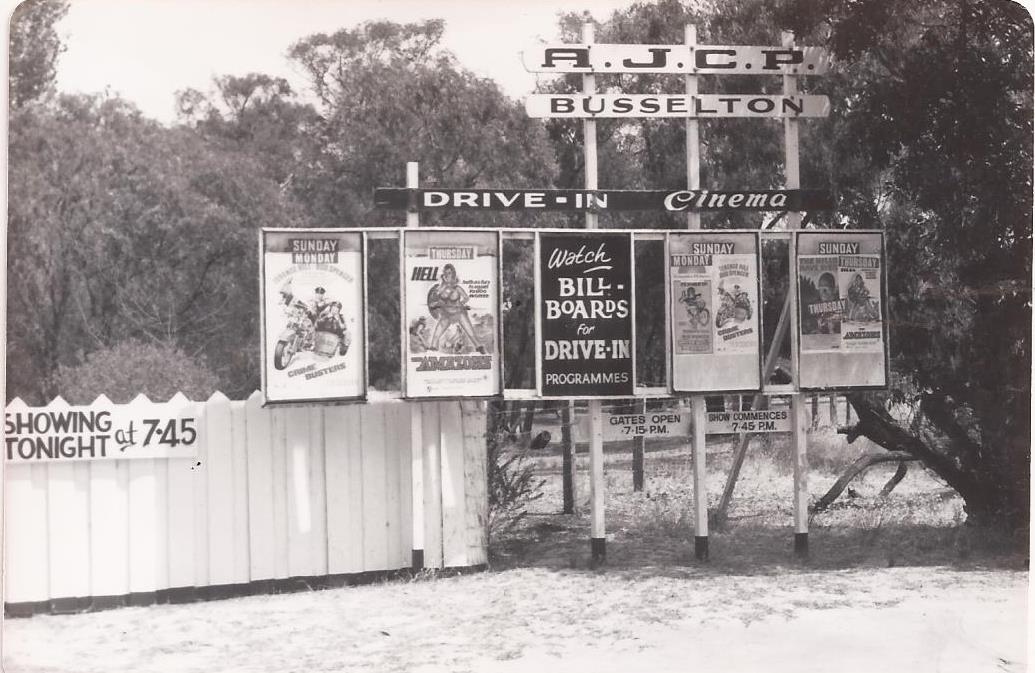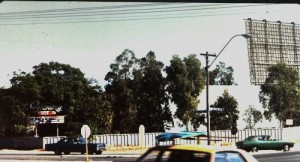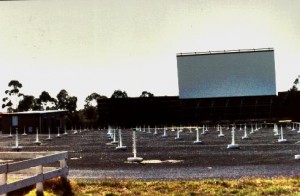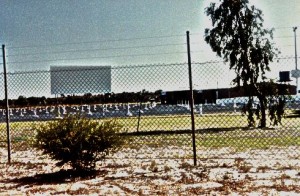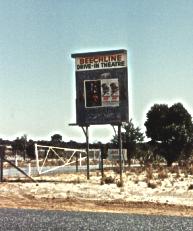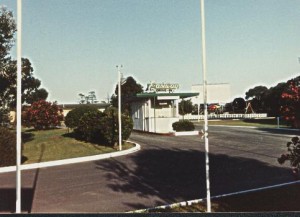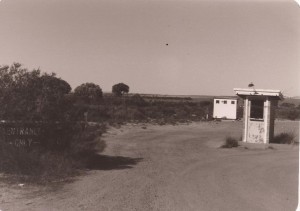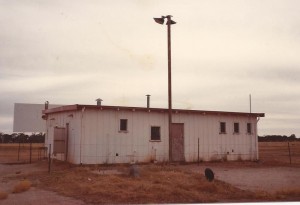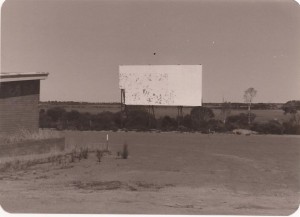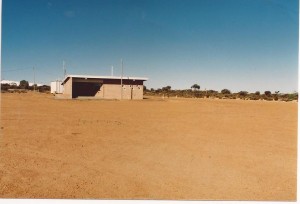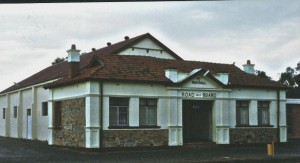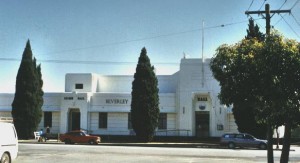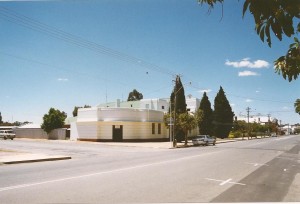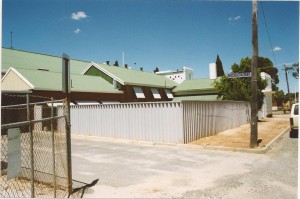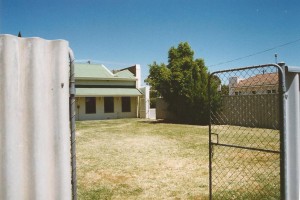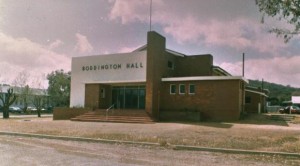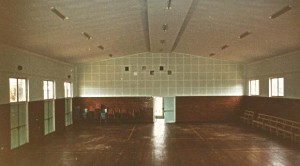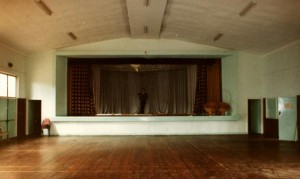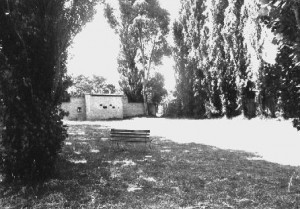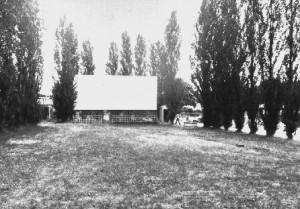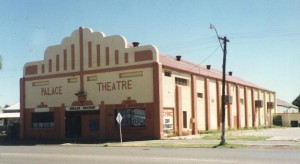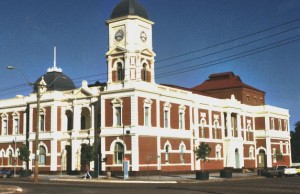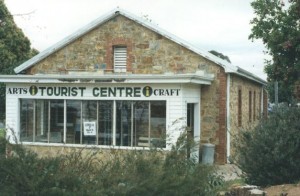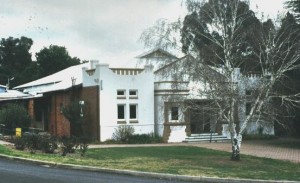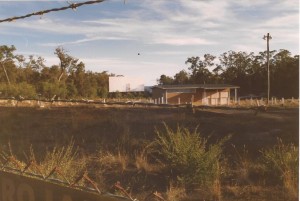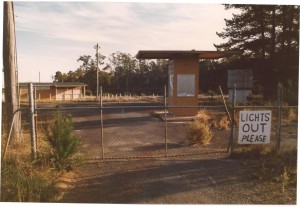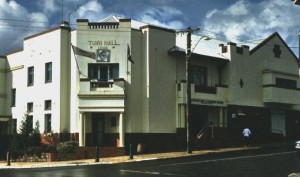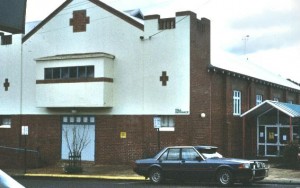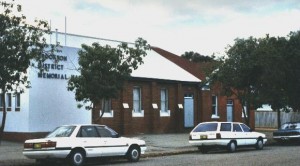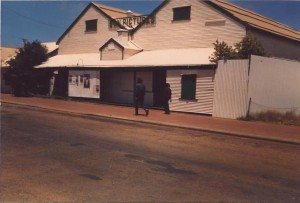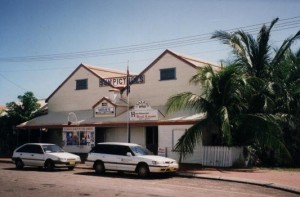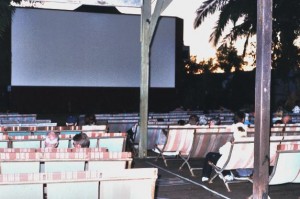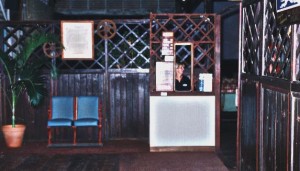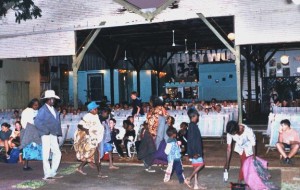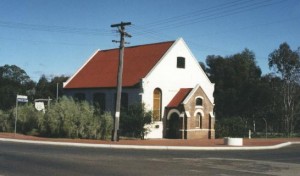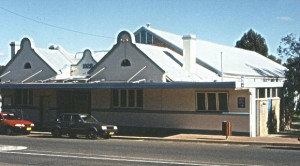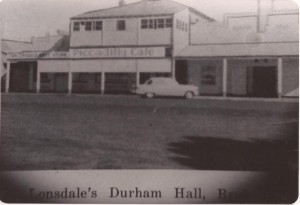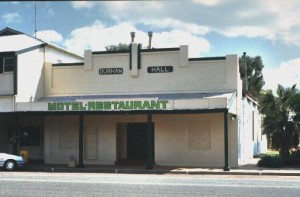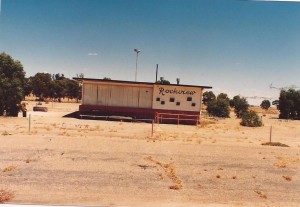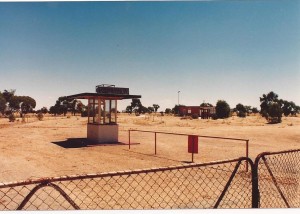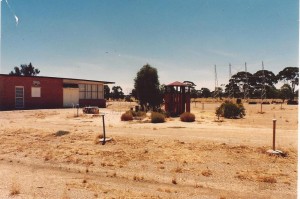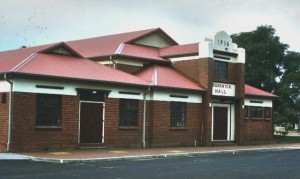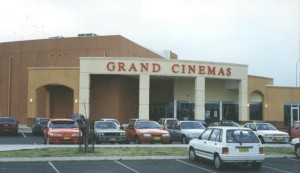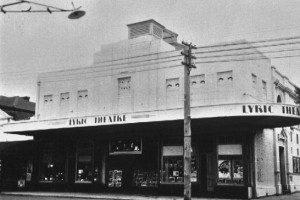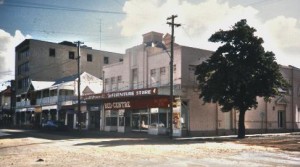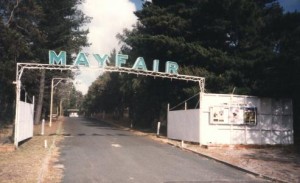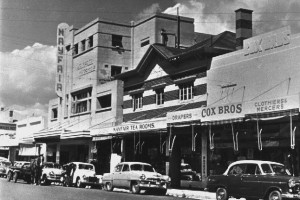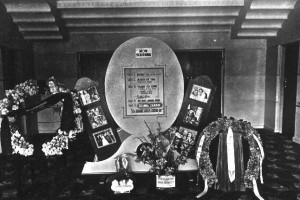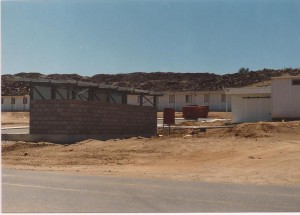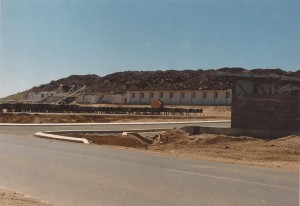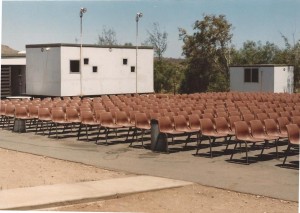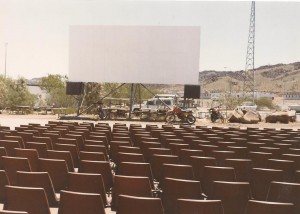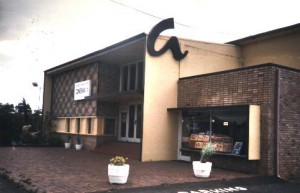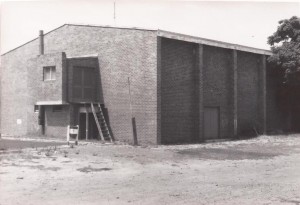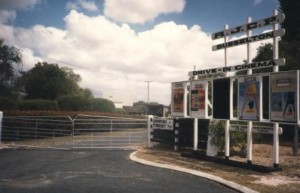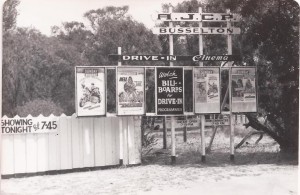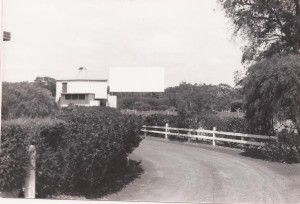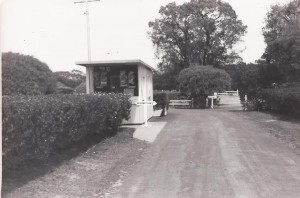Quicklinks
BAKER’S HILL
The HALL
In the late forties and early fifties, Fitzgerald’s Circuit Pictures regularly visited Baker’s Hill.
Sources: Film Weekly Directory, 1948/9 – 1950/51
BALCATTA
GLENWAY DRIVE-IN THEATRE ,Wanneroo Rd, Balga
The Glenway drive-in, with provision for 300 cars, was built for Ace Theatres in 1967, on the western side of Wanneroo Rd, Balga (now part of Balcatta). It was closed and demolished in 1985, and is now the site for the Stirling Gate shopping centre.
Sources: Public Health Department, building permit, Battye 1459
Max Bell, Perth – a cinema history, The Book Guild, Lewes, Sussex, p.127
Film Weekly Directory 1966/7-1971
West Australian 1967-1984
Interview (Ina Bertrand): Arthur Stiles (1985)
Photos: 2 colour exteriors, 1981 (Bill Turner)
BALINGUP
AGRICULTURAL HALL/ ROADS BOARD HALL cnr Jayes Rd and Roberts St, Balingup
The Agricultural Hall was built about 1905 with a government grant to the Farmers and Settlers Association. The Municipal Heritage Inventory describes it in 1996:
This red brick building has flat gauged arches above the windows. The mortar joints have been painted white, which gives the whole building a very striking checkered appearance. A double jarrah door entrance is on Jayes Rd side, with a single door on Robert St. The open fire place has been converted to a servery from the kitchen, with narrow ramps each side leading to the kitchen area. The ceiling is of T&G pine (Cedar), while the interior walls are rendered and painted.
In 1930 the old hall became the supper room for the new hall, built on its west side. In 1996, this complex is described in the Municipal Heritage Inventory:
Situated on the corner of Robert Street and Jayes Road, and incorporating the original Agricultural Hall into the design, a new red brick hall was built, using stone foundations because of the sloping site. It has an iron roof, wide cement ramp entrance, ticket box, large jarrah double doors into the entrance foyer, double jarrah doors to the mail hall, double doors on the eastern side to the supper room (old hall), and double doors on the west side exit. At the southern end is a wooden stage area with stairs on both sides. Behind the stage, with a weather board and fibro exterior are storage and dressing areas. Leading off the main foyer are a powder room and therapy room. Next to the entrance ramp is a separate office, now the library, formerly the Roads Board Office and Shire Office. Above the library is the old projector room, with access from outside by stairway (since removed). Internal/external toilets are connected to the hall. There is also an honour roll for armed service personnel.
Local historian A.C.Frost describes how these halls were used from very early for motion pictures:
Mr Rob Lukis can remember when the first pictures were screened in Balingup in 1906. It was a biograph operated by Bartlett’s pictures. As a young boy Mr Joe Bovell remembers the time he used to turn the handle of Mr Fred Leach’s cinematograph which he brought from Donnybrook to Mullalyup. For this service young Bovell was allowed in free. These shows operated only spasmodically. (p.49)
He also explains how a district with such a small and dispersed population came to have two pictures shows:
When the new hall was built in 1930 the Board had several requests for a screening of pictures, which by then had reached a much higher standard than the early ´flicks’. Three operators, H. Delavale, F.West and E.Hawter were given the right to screen pictures once a month on a rental charge of 35/- a night. Two years later this arrangement was rescinded. Talkies were introduced and F.E.West was given the right to screen once a fortnight. Pictures were screened on a Saturday night and as this was the night when most local organisations wanted to conduct dances, concerts and such like functions, there was inevitable conflict between the two interests. West had a disagreement with the Board and decided to build his own hall and screen pictures independently. In March 1936 he submitted plans and specifications for a hall on Lot 16 and these were signed by the chairman, W.M.Jenkins. This brought loud cries of protest and a special ratepayers’ meeting was convened to protest at the Board’s action in granting permission for a hall to be erected in opposition to the district hall. The chairman justified the action by explaining that it was not the Board’s policy to interfere with private enterprise.
In the meantime Gray and Friend were granted the sole right to show pictures in the district hall fortnightly at £2 per night. Gray himself took over the contract in April 1927 and by then West was showing in his own hall. Inevitably this led to a clash of dates for picture nights despite the fact that ´talkie’ pictures were enjoying a boom at this time, The result was that in June 1939 West took over Gray’s picture contract and the Board was left without a tenant. In September the Board invited Goldfields Pictures to rent the hall for pictures but eventually S. Jeffries took over the picture rights for the district hall. (pp.49-50)
Film Weekly Directory lists Balingup on A.H.Jeffries’ circuit from 1958/9-1964/5.
Sources: Film Weekly Directory 1958/9-1964/5
Shire of Donnybrook/Balingup, Municipal Heritage Inventory, Place nos. 48, 48(a)
Max Bell, Perth, a cinema history, The Book Guild Ltd, Lewes, Sussex 1986, p.100-101
A.C.Frost, Baylya-Balinga: a history of Balingup, Donnybrook-Balingup Shire Publishers 1979, pp.49-50
WEST’S HALL , Forrest St, Balingup
Balingup already had a large and commodious public hall in 1930, when Fred West decided to build his own hall for use as a picture theatre. The Municipal Heritage Inventory describes West’s like this:
The Balingup Picture Theatre Hall was built in 1936. The owner, Fred West, screened pictures there until 1958 when he sold the business to Mr Wilfred Walter, who leased the premises to Mr Henry Gruber. The picture theatre is a large weatherboard and iron roof hall, 30 x 60 ft, lined with 18″ jarrah skirting board and jarrah dado approximately 6ft. The continuation of the building has cardboard fibre board walls and ceilings in panels with jarrah battens. The frontage consisted of an enclosed ticket office (west side) and projector room (east side, with outside steps). Between double entry doors two sets of double doors exists. Four sets of upright windows separated outside toilets at far boundary on laneway (now demolished) facing Forrest Street.
The vacant land adjoining building is the site of the outdoor theatre also operated by Mr West. The projector viewing area was from the east side of the projector room. The screen was placed on the eastern boundary of lot 16. A wooden planked fence on the street side screened this from public viewing. Deck chairs from the theatre were used. Mr West had his own power plant for the theatre before being connected to the town SEC supply.
Local historian, A.C.Frost, describes how a district with such a small and dispersed population came to have two pictures shows:
When the new hall was built in 1930 the Board had several requests for a screening of pictures, which by then had reached a much higher standard than the early ´flicks’. Three operators, H. Delavale, F.West and E.Hawter were given the right to screen pictures once a month on a rental charge of 35/- a night. Two years later this arrangement was rescinded. Talkies were introduced and F.E.West was given the right to screen once a fortnight. Pictures were screened on a Saturday night and as this was the night when most local organisations wanted to conduct dances, concerts and such like functions, there was inevitable conflict between the two interests. West had a disagreement with the Board and decided to build his own hall and screen pictures independently. In March 1936 he submitted plans and specifications for a hall on Lot 16 and these were signed by the chairman, W.M.Jenkins. This brought loud cries of protest and a special ratepayers’ meeting was convened to protest at the Board’s action in granting permission for a hall to be erected in opposition to the district hall. The chairman justified the action by explaining that it was not the Board’s policy to interfere with private enterprise.
In the meantime Gray and Friend were granted the sole right to show pictures in the district hall fortnightly at £2 per night. Gray himself took over the contract in April 1927 and by then West was showing in his own hall. Inevitably this led to a clash of dates for picture nights despite the fact that ´talkie’ pictures were enjoying a boom at this time, The result was that in June 1939 West took over Gray’s picture contract and the Board was left without a tenant.
The Board then invited other exhibitors, who continued to screen in opposition to West’s hall. But West’s continued till 1958, when the premises were used as a packing shed, and then as a residence.
Sources: Film Weekly Directory 1940/41 – 1957/8
Shire of Donnybrook/Balingup, Municipal Heritage Inventory, Place no.36
Max Bell, Perth, a cinema history, The Book Guild Ltd, Lewes, Sussex 1986, p.100-101
A.C.Frost, Baylya-Balinga: a history of Balingup, Donnybrook-Balingup Shire Publishers 1979, pp.49-50
BALLIDU
HALL
Ray Dean sold his circuit to Neil McKee and Dave Cox in the fifties. They screened in Ballidu fortnightly, and this continued after Vic Basham bought McKee’s share of the business. After Basham and Cox separated, Basham continued fortnightly screenings in Ballidu, till they ceased once drive-ins began to open in the area.
Sources: Film Weekly Directory , 1940/41 – 1950/51
Interview (Ina Bertrand): Vic Basham (1997)
BANKSIADALE
CENTENNIAL HALL
The town that grew up around No.2 State Mill was later named Banksiadale. It was owned by State Building Supplies, and was the most modern mill town of its time, the only one with electricity. It survived the 1961 fires that burned out nearby Dwellingup, but in 1963 the mill was sold to the Hawker Siddeley Group in England. On 24 June 1963 the mill itself was razed by fire. Company Secretary M. Ledingham was quoted as saying: the fire ´neatly removed the main building… Thousands of pounds worth of sleepers and other stock was nearby, some of it within ten yards of the mill. Yet this was untouched.’ (West Australian 24 June 1963) The townsfolk were suspicious of this fire, even though the company promised its 110 employees that they would be re-employed and the mill rebuilt. Instead, the workers were re-employed by adding an extra shift at Dwellingup: the Banksiadale mill was never rebuilt, 34 mill houses were relocated to Dwellingup, and businesses closed down, leaving the town almost deserted, but some older residents stayed on till they were forced to leave. For this town was submerged under the South Dandalup Dam, opened 8 February 1974 as part of the water supply system for Perth.
While the town was still alive, films were regularly screened in the Centennial Hall, which could seat 250 people: for instance, W.A.Redman is listed as screening there one night per week from the early forties to the early sixties. This was another of those country towns where young boys would ride round on their bikes ringing a bell to warn of the arrival of the picture show that night.
Sources: Film Weekly Directory 1940/41 – 1962/3
Elsie Turner, ´Death of a mill town’, Countryman, 10 September 1970, p.46, West Australian 24 June 1963, p.1
BASSENDEAN
(BASSENDEAN PICTURE GARDENS)\ WONDERVIEW PICTURES , 14-16 Old Perth Rd (now Guildford Rd), Bassendean
This was numbered 194 Old Perth Rd, at the time that the venue opened in 1927 (It may have opened as Bassendean Picture Gardens earlier than this – 1925?). From the Post Office Directory, it seems to have been built on the north side of Guildford Rd, west of Wilson Street, and in the middle of a strip of shops: the entrance may have been between the shops, with the picture gardens located behind the shops. It was a simple open air pictures, without a hardtop, and was run by the Snook family, who also ran the Lyric (Maylands): however, the nearby Town Hall was used for an indoor venue in cold or wet weather, when this did not conflict with the screenings by the regular Town Hall exhibitor. The Wonderview closed in 1946, and the site was later used for a shopping arcade.
Sources: Jennie Carter, Bassendean: a social history 1829 – 1979, Town of Bassendean, Perth WA, 1986, pp.196-7, 265, Post Office Directory 1927 – 1946
Interview (Ina Bertrand): R. Yelland (1985)
Photos: 1 exterior (shopping arcade), colour, 1981 (Bill Turner)
WEST GUILDFORD HALL/ TOWN HALL AND GARDENS/ARCADIA AND GARDENS, 48,54 Old Perth Rd (now Guildford Rd), Bassendean
Bassendean was at first the west ward of the Shire of Guildford. The first films screened in the district were probably in the West Guildford Hall, built on the north side of Guildford Rd, east of Wilson St. Screenings may have begun in 1913, and certainly one early screening took place on Boxing Day 1914. Bob Yelland remembers that Mr Flood, who also operated the Vaudeville Theatre in Guildford Town Hall, provided film screenings in the West Guildford Town Hall in the early silent period (at least from around 1910).
So, regular screenings in the Town Hall seem to have been running before the Wonderview was opened in the next block: early proprietors of the Town Hall pictures were Mr Jones of the Majestic Picture Company, then Frank Piaggio and later Paddy Baker. Bob Yelland was an operator for both the latter, then took over the business himself, at first in partnership with Cameron and later on his own (as Greater X-L Tone Amusements). In the silent days the show had a seven-piece orchestra.
In approx. 1937, a new gardens, with lawns and trees, was built next door to the hall, and named the Arcadia Gardens. For some time both the Arcadia and the Wonderview open air venues co-existed, but the Arcadia was the longer-lived, surviving till 1963.
The Bassendean Town Council buildings are now on the site of the early hall, and the Senior Citizens centre on the site of the gardens.
Sources:Max Bell, Perth – a cinema history, The Book Guild, Lewes, Sussex, 1986, p.20
Jennie Carter, Bassendean: a social history 1829 – 1979, Town of Bassendean, Perth WA, 1986, pp.196-7, 265
Film Weekly Directory, 1943 – 1962
Post Office Directory, 1926 – 1949
West Australian, 26 December 1914; 1937 – 1963
Interview (I. Bertrand): R. Yelland (1985)
BAYSWATER
BAYSWATER HALL AND GARDENS 7 Slade St, Bayswater
The first Bayswater Roads Board Hall was opened in 1898, but the current building was opened 24 September 1914, and soon was used for a regular weekly picture show, operated first by a Mr Nielsen, then Mrs Jones, then Mr Robinson. Screenings ceased for a while in the early days of talkies, but resumed in 1936 when this venue was part of R.R.Perrie’s circuit, which also included Gosnells, Armadale, Queens Park and Rivervale. The hall held 350 people, and in 1953 a gardens seating a further 400 was added, next door to the hall. Screenings continued till 1967. In 1997 the hall was used as a church, and the gardens site was a carpark.
Sources: Max Bell, Perth – a cinema history, The Book Guild, Lewes, Sussex, 1986, p.20
Max Bell, ‘Bayswater cinema’, Kino 74, Summer 2000, p.31
Film Weekly Directory, 1940/41 – 1966/7
Post Office Directory, 1940 – 1949
West Australian, 1954 – 1967
Photos: 1 exterior (old hall visible behind new front section), colour, 1981 (Bill Turner)
BECKENHAM
WAVERLEY DRIVE-IN THEATRE ,cnr Camberwell & William Sts, Beckenham
The Waverley drive-in, with provision for 530 cars, was built by a consortium, of which Goldfields Pictures was the largest shareholder. It opened 31 December 1964, on the corner of William, Camberwell and Sevenoaks Sts: this location between the Albany Highway and the railway line allowed easy access both by car and, for those still without such transport, by train, as it was next to Beckenham station. It was operated at first by Alan Larkin, using mainly Metro product, then in 1971 it was absorbed into the Ace group. In 1985 it was leased on a monthly tenancy to an independent operator, but it closed in May 1989 and the site was cleared for a housing estate (though nothing had been built there by mid-1997).
Sources: Public Health Department, building permit, Battye 1459
Max Bell, Perth – a cinema history, The Book Guild, Lewes, Sussex, p.129
Film Weekly Directory, 1964 – 1971
Kino no.25, September 1988, p.23; no.29, September 1989, p.23
West Australian, 26 February 1964, 29 July 1964, 31 December 1964, 1964 – 1988
Interview (I. Bertrand): Arthur Stiles (1985)
BEDFORD
BEDFORD PARK GARDENS, Walter Rd, Bedford
This site was bought by the manager of the Capri cinema, but he died soon after and the land was sold to Goldfields Pictures. They built the gardens in 1955 on the corner of Grand Promenade, and sold it in 1960.
Sources: Max Bell, Perth – a cinema history, The Book Guild, Lewes, Sussex, p.55
West Australian, 1957 – 1960
Interview (I.Bertrand): R. Elsegood (1985)
BEECHBORO
BEECHLINE DRIVE-IN THEATRE, Beechboro Rd, Beechboro
This drive-in was the 83rd in the state, and the 17th in the metropolitan area. It is technically in Ballajura, but the area is popularly described as Beechboro, and the drive-in draws its name from that suburb. It was built on the north-west corner of Marshall Rd for City Theatres, at a cost of $250,000, and opened 24 February 1971/2.
The cinema was designed by architects Broadhurst, Ryan and Evans, with provision for 500 cars:
The Beechline Drive-in is the first in Western Australia with a cafeteria specially designed for self-service. The screen is equal to the biggest in the State, with an area of 96 feet by 43 feet. The most modern equipment has been installed and this can be adapted for 70mm. A sit-in area can accommodate 40 patrons and the 13 acre site allows for future expansion.
The drive-in will be landscaped and a children’s playground is to be built. (Australasian Exhibitor, February 1972)
In 1983, City Theatres bought the 70mm projectors from the Central 70 when that drive-in closed in Albany, and had them installed in the Beechline. The venue seems to have ceased screening in 1985. In 1988 Hoyts took over City Theatres, and immediately closed all six drive-ins: the Beechline was put on the market for $300,000, but was slow to sell. In 1997, Potter’s House Christian Centre was located on the site.
Sources: Film Weekly Directory 1971
Public Health Department, building permit, Battye 1459
Kino, no.25, September 1988, p.23; no.26, December, p.23
West Australian, 1972 – 1985
Interview (Ina Bertrand): Alan Crew (1997)
Photos: 2 exterior, colour, 1981 (Bill Turner)
BELLEVUE
HALL
Film Weekly Directory lists Bart Mott’s Star Entertainments circuit as screening in Bellevue 1951/2-1952/3, then A.E.Randell’s circuit 1953/4-1957/8.
Sources: Film Weekly Directory 1951/2 – 1957/8
BELMONT
BELVEDERE GARDENS, Belvedere St, Belmont
This gardens, built on the eastern corner of Belvedere and Gardiner Sts and holding 200 patrons, was run by the Fitzgerald family. It opened in 1948 and closed in 1961.
Sources: Film Weekly Directory, 1948 – 1962
West Australian, 1953 – 1961
EASTWAY DRIVE-IN THEATRE, Golf St, Belmont
This drive-in was part of the Ace chain. It was built between Harold and Golf Streets, and opened 20 July 1959, with a capacity for 460 cars, which was later increased till it could cater for 590 in 1971. It closed for three years in the eighties, then opened again (no ads after 1985?). In 1988 the site was sold for use as a public car market.
In 1997 it was a housing estate. The highway had been remade (Resolution Drive added) and an entirely new subdivision had obliterated all traces of Harold and Golf Sts, which were approximately where Lakewood Ave and Crake Sts are now.
Sources: Film Weekly Directory 1959/60 – 1971
Public Health Department, building permit, Battye 1459
Max Bell, Perth – a cinema history, The Book Guild, Lewes, Sussex, p.126
Vyonne Geneve, ´William Leighton, architect’, Kino, no.25, September 1988, pp.7 – 15
Film Weekly, 23 July 1959, p.3
Film Weekly Directory, 1960-1971
Kino, no.23, March 1988, p.23; no.25, September 1988, p.23
West Australian, 1959 – 1985
Interview (I.Bertrand & Bill Turner): John Pye (1981)
Photos: 1 exterior, colour, 1981 (Bill Turner)
READING CINEMAS BELMONT, Belmont Ave, Belmont
This $13m ten-cinema complex within the Belmont Forum, was opened by Readings in December 1999, despite earlier opposition from Hoyts (which claimed the Council had not taken parking into consideration when granting the permit).
Sources: Kino, no.63, Autumn 1998, p.34; no.66, Summer 1998, p.30; no.70, Summer 1999, p.35
BENCUBBIN
BENCUBBIN DRIVE-IN, Monger St, Bencubbin
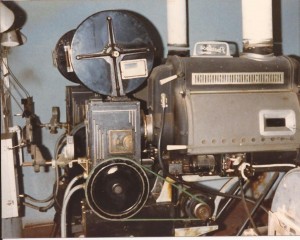
Projector room Bencubbin 1980’s
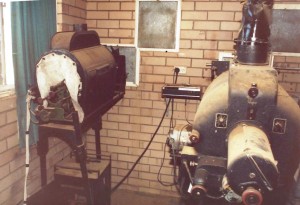
Bencubbin Drive in 1987. The Projection Room
This small drive-in, holding only 75 cars, was built on shire land at the southern end of Monger St. It was operated by J.M.Tilka of Perth, and opened in 1964/5? John Marsden took it over in the late seventies, until it was partly dismantled in 1980, then completely demolished to make way for the Shire Caravan Park which now occupies the site.
Sources: Film Weekly Directory 1966/7 – 1971
Public Health Department, building permit, Battye 1459
Max Bell, Perth – a cinema history, The Book Guild, Lewes, Sussex 1986, p.131
Max Bell, Kino, no.13, September 1985, p.14
F.H.Broomhall, Mount Marshall: a history of its people from earliest times to 1942 , Shire of Mount Marshall, 1983 Interview (Ina Bertrand): John Marsden (1997)
Photos: 3 exterior & 1 interior, 1980’s, Max Bell.
1 interior and 1 exterior, colour, 1987, Roy Mudge
MOUNT MARSHALL ROAD BOARD HALL/ MOUNT MARSHALL SHIRE HALL, Monger St, Bencubbin
The first Bencubbin Hall was built in 1921, of weatherboard and iron, before the Mount Marshall Roads Board was officially constituted in 1923. The first pictures shown there were by Delavale and Nelson, touring through regularly from 14 March 1922.
Soon after, Paddy Baker’s silent film circuit included Bencubbin, screening fortnightly on a Monday. Baker remembered it like this:
I first started showing pictures in the Mount Marshall district about the time the first hall was built in Bencubbin on a block behind the pub. I remember this hall particularly – it had a room at each corner of the building. The projector would be between the two rooms at one end of the hall, while the car would be positioned outside. I had a 1914 Dodge at first, then a T-model Ford, ran the projector off the rear wheel – jacked up one wheel. Another time I had a Silver Anniversary Buick and used to drive the projector off its gear box. (quoted in Broomhall, p.244)
The new hall was built for the Roads Board on the eastern corner of the intersection of Monger and Rupe Streets and opened on 30 July 1927. It was a stone and brick building with a symmetrical facade: the roof was corrugated iron on the hall section and tiles on the front office section. It had a floor space 60ft x 40ft and toilets and landings were added at the rear of the building in the fifties.
Early in 1928 Baker had a fire in the projector, but extinguished it promptly by closing the fireproof door of the bio-box, much to the relief of patrons. Perhaps it was to re-establish his reputation with the locals that in 1929 he donated a handsome cover for the panatrope machine, used to provide mechanical music for the dances also held in the hall. He introduced sound films to the town in 1932:
I ran a show called ´The Robe’ at Bencubbin in the then new Road Board hall, with sound. To make it good I had two big speakers. It was raining a gale that night with rain beating on the windows in a continual roar. When it came to the point where Judas says “I have betrayed him”, I turned those loud speakers on full belt and what with this noise inside and the rain roaring outside there was quite a sensation. One lady who had a miscarriage shortly afterwards blamed me and my sound pictures for it! (quoted in Broomhall, p.244)
It is not clear when screening in the hall ceased, but probably by the mid-sixties.
Sources: Film Weekly Directory 1940/41 – 1964/5
Mount Marshall Shire, Municipal Heritage Inventory, MM 02
Max Bell, Perth – a cinema history, The Book Guild, Lewes, Sussex 1986, p.131
Max Bell, Kino, no.13, September 1985, p.14
F.H.Broomhall, Mount Marshall: a history of its people from earliest times to 1942, Shire of Mount Marshall, 1983
Photos: 1 exterior, b&w, n.d, Mount Marshall Shire, Municipal Heritage Inventory, MM 02
1 exterior, colour, 1997, Graeme Bertrand
BENTLEY
HIGHWAY DRIVE-IN THEATRE 1235 Albany Highway, Bentley
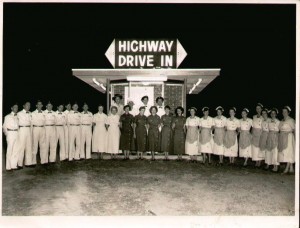
This was Western Australia’s first drive-in, opened by the Lord Mayor of Perth at a gala preview screening of The Greatest Show on Earth on 13 October 1955. It was built for Ace Theatres to the design of architects Hobbs, Winning and Leighton. Building was hampered by unseasonal weather – high winds and heavy rain, which made problems for contractors not yet accustomed to such forms of construction.
It had a permit for 650 cars on its fifteen acres, but began more modestly with 500 at first: this was soon increased, and by 1971 it could hold 712. Because of its novelty, it was necessary to explain to potential patrons just what they could expect from such a place:
The theatre, which is only 5½ miles from the Perth G.P.O., is designed for family entertainment.
Services offered will include a trained nurse to care for infants.
The screen will be erected 18ft. above the ground, and will be 50ft. long and 36ft. deep.
All vehicles will be equipped with individual microphones, and customers will be able to regulate the sound-track volume to their own requirements.
By pressing a button on the microphone – which hooks onto the car dashboard – patrons will receive prompt service.
Cinemascope and other modern film equipment will be installed.
Cars will have easy access to the theatre, customers paying at a turnstile-type entrance, and exits will allow for a rapid flow of traffic.
All patrons will receive a good view of the screen because of the installations of drive-over ramps, which give the vehicles added elevation.(West Australian, 19 February, 1955)
A further explanation was given in a short film shown early in the programme to those first patrons. The screen when finally erected was actually 42ft by 62ft. – the largest in Western Australia at that time. A permanent caretaker lived in a house on the site, and a 500-car holding area was provided as well as a children’s playground, a crazy golf course, food service right to your car, as well as a restaurant that served full meals. A uniformed staff attended patrons, just like those in the first-run hard-top venues. The venue was a great success and as people became accustomed to the idea other drive-ins proliferated.
The Highway was twinned in 1986 in anticipation of the closure of the Mellway, but closed in September 1994 and the site was sold for $2.5 mill, for housing development (a motel and housing estate had been built by 1997).
Sources: Public Health Department, building permit, Battye 1459
Max Bell, Perth – a cinema history, The Book Guild, Lewes, Sussex, p.127
Daily News, 6 March 1958
Film Weekly, 20 October 1955
Film Weekly Directory, 1955 – 1971
Kino, no.48, June 1994, p.32; no.49, September 1994, p.31
West Australian, 19 February 1955, 24 October 1955, 1955 – 1985…
Interview (I.Bertrand): Arthur Stiles (1985)
Photo: 1 exterior, b&w, n.d., Stage, Screen and Stars, West Australian, n.d. (1997?), p.44
MELODY GARDENS, Queen St, Bentley
This simple open air cinema opened in 1953/6?, introduced cinemascope in 1957, and closed 1964.
Sources: Max Bell, Perth – a cinema history, The Book Guild, Lewes, Sussex, p.60
West Australian, 1956 – 1964
BEVERLEY
BEVERLEY DRIVE-IN 18 Hunt Rd, Beverley
Graham Ford built this drive-in in Hunt Rd on the east corner of Taylor St, on Council land, and opened it in 1965 (Bell says May 1966).
In 1966, Peter Thomson (the eight-year-old who had earlier assisted Ford at the hall screenings) took over the lease, while Graham Ford went north working on refrigeration. When Thomson shifted to Kambalda in 1967, he left the Beverley drive-in in the care of his brother George, but still organised film supply. They were running only one night a week, but Ford wanted it open more than that, so took the lease back. Brian Richard assisted Ford in Beverley, then in other drive-ins on Ford’s circuit, before taking over Kulin drive-in himself.
Facilities from the Beverley drive-in were transferred to Hyden in 1975. The site is now used by Lotex Carriage Works.
Sources: Film Weekly Directory 1965/6 – 1971
Public Health Department, building permit, Battye 1459
Max Bell, Perth – a cinema history, The Book Guild, Lewes, Sussex 1986, p.131
Interviews (Ina Bertrand): Peter Thomson (1997), R.Yelland (1985)
TOWN HALL AND GARDENS, Vincent St, Beverley
The Salvation Army Biorama Company visited the town in October 1900 and again in September 1902, and they may have used the old Town Hall, on the west side of Vincent St, not far down from Hunt St, which burned down. The new Town Hall was built on the same site, with the foundation stone laid on 1 September 1938.
Beverley was surprisingly well-served by the early travelling shows. Stevenson’s Royal Biograph appeared there in December 1904 and January 1905 on the way to and from Albany, and the Corrick family, with Leonard’s Beautiful Pictures, visited in July 1907 and again in October 1909. In July 1907, the Taits brought the Kelly gang film and in January 1908 they screened Robbery under arms. The Musical All-Blacks and Page’s Supreme Pictures visited in April 1908. Alf Wheat (later of Geraldton) began his career in pictures operating a circuit which included Beverley in 1913-14, before he went to the First World War.
Percy Lambert ran the power plant and took on the picture show as well. When he went to World War 1, his brother Ernie Lambert supervised the business, and installed Mr L. Swan as manager. Percy Lambert returned from war with consumption and moved to Albany, selling the business to Swan, who operated there till at least 1928.
The next person to run the picture show in the old hall was probably Selby Ford, who was certainly there when the new hall was built. But Bob Yelland remembers that Consolidated Theatres won the tender, established an open air gardens beside the new hall, but closed early (1941?). MPDA records show Ford and Ford as proprietors of the Town Hall and Gardens 1942-44, screening two nights per week. So, it seems like that the show in the hew hall was run first by Selby Ford, then Yelland, then Selby and Graham Ford before they opened the drive-in. Peter Thomson, later of Coastal Cinemas which controlled the cinemas of Fremantle and Rockingham in the nineties, entered the industry as an eight-year-old, assisting Graham Ford on the slide projector in Beverley.
Sources: Film Weekly Directory 1940/41 – 1964/5
Max Bell, Perth – a cinema history, The Book Guild, Lewes, Sussex, 1986, p.101
Everyone’s, 1 February 1928, p.16
Interviews (Ina Bertrand): Peter Thomson (1997), R. Yelland (1985)
Limelight Picture Show Tours, http//:www.abc.net.au/limelight/docs/tours
Photos: 1 exterior, colour, 1997, Graeme Bertrand. 3 exterior photos, colour, 1998, Roy Mudge
BIG BELL
PALAIS AND GARDENS/ HALL AND GARDENS 107-8 Pitt St, Big Bell
The Big Bell gold mine, 29 km west of Cue, opened first in 1904 but only for a short time. In 1913 it was re-opened by Jim Chesson and Bill Heydon, who worked it till 1926. From 1933 there were moves to re-open it and in 1935 the American Smelting and Refining Company took up the option.
The mine was declared open again on 2 October 1937, celebrated in the Palais Music and Dance Hall, with a glittering Hospital Ball. A special train brought the state Governor from Perth, with three hundred guests in full evening dress, dancing to Ron Jenkins’ popular dance band, and returning next morning at 3 a.m. The town of Big Bell soon became a thriving centre, with a hospital, hotel, post office, ice works, power house, many shops, and a Catholic Church.
Consolidated Theatres were screening in the Palais in 1938, and in the adjacent gardens. Both venues held 250 people, and one or the other was screening twice a week, depending on the weather. But within twelve months the building had burned down, and, as no insurer had been willing to take the risk on a cinema in a town without a reticulated water supply, the company had to bear the loss itself. Temporary premises were used – at first in the open air, then in a small hall – but the Big Bell cinema was never again of the quality of the first Palais.
In 1939, the town voted in a referendum to decide whether to build a new hall, and support was not universal as the shopkeepers in particular resented the additional rates that would be levied. However, the measure went ahead and the levy of seven pence in the pound funded the new hall. The second hall and gardens were of similar design to that in Cue. The simple corrugated iron hall had a built-in ticket box which could serve both venues. The gardens was built alongside, surrounded by a high corrugated iron fence, with entry beside the hall, under the bio-box which the two venues also shared. The concession servery was located in the front corner of the gardens, on the far side from the hall. The venue was used for other purposes as well as pictures: for instance in February 1940 a public meeting about the hospital was held there. The mine closed during World War 2, from 1943 to 1945, but the town survived this and revived after the war.
Bill Pigdon was the projectionist from his return from World War 2 in 1946 till the venue closed: Consolidated Theatres still owned the venue, which offered screenings on Monday, Wednesday and Saturday until the mine closed in 1954. George Yelland, who was cinema manager, was reputed to have green fingers – he made the open air venue look like a real gardens, with trees and shrubs along the back and side walls. Seating was on five-seat wooden-framed deckchairs.
After the mine closed, the town was deserted and gradually disappeared, though the venue continued to be listed in the Film Weekly Directory until 1960/61. In 1987, Australian Consolidated Minerals re-opened the mine and began open-cut operations the following year, but no town has grown up around it. In the nineties, Big Bell is a ghost town, with only some remains of the hotel and church left, and no sign of the cinema.
Sources: Film Weekly Directory 1940/41 – 1960/61
Ann Paterson, The history of Big Bell, Graylands College 1965
Interview (Ina Bertrand): R.Yelland
Informant: Jean Pigdon (1997)
BINDOON
HALL
Regular screenings were conducted here from the late thirties to the early sixties: Ray and Keith Martin remember pushing bikes seven miles from Chittering to see the pictures in the mid-1940s. Fitzgerald Circuit Pictures were in Bindoon from at least 1948 to about 1953, then Lew Punch from the late fifties to the early sixties, then J.Tilka. John Marsden showed twice in Bindoon, in about 1969/70, but abandoned the screenings in the town because of an unreliable power supply. Still later, Steve Marvin screened there occasionally on 16 mm.
Sources: Film Weekly Directory 1948/9 – 1950/51, 1952/3 – 1953/4, 1958/9 – 1962/63
Max Bell, Perth – a cinema history, The Book Guild, Lewes, Sussex, 1986, p.102
Interview (Ina Bertrand): John Marsden (1997), Roy Mudge (1997)
Informant: Valma Martin (1997)
BODDINGTON
BODDINGTON HALL AND GARDENS, Johnstone St, Boddington
Local historian John Ferrell describes how the first Boddington hall came to be built by a local committee, opening in 1923. It was a timber hall, holding 350, and with a built-in asbestos bio-box. It was on several circuits operated over the years by different people, including ´Roch’ Evans up to about 1939, then Charlie Legg, who opened a gardens next door. From 1944, Legg and R.H.Gordon held the power concession in Boddington, and soon after this Gordon relinquished his share. As happened in so many country towns, Legg supplemented the income from the powerhouse with the profits from the weekly picture show, in either the hall or the gardens.
In the forties responsibility for the hall was taken over by the Marradong Roads Board, and in the fifties discussions began about the need for a new hall, which was eventually built on the same site – the north-east corner of the intersection of Johnstone and Wuraming Sts, Boddington. This opened on 10 March 1956, again with a built-in bio-box, ready for film screenings, and tenders were called for these. The Council accepted that from Jimmy Punch, above the established exhibitor – Charlie Legg, but Punch did not succeed in establishing himself in the town (he is listed in the Film Weekly Directory for 1960/61 to 1962/63) and Legg returned. The Council did not support his building a new gardens, so he purchased land two streets away and built there. All the seating was on grass, with Koolama chairs around the sides and deckchairs in the middle. Poplar trees were planted along the sides, and the venue was very pleasant in summer: whole families would come along, parking babies in prams beside the aisle. Legg continued to screen in Boddington Hall and gardens into the early sixties, after he had sold the rest of his circuit.
The gardens site is now vacant. The hall, however, is now on the Suburban Pictures circuit, operated by Steve Marvin, so in the nineties pictures still occasionally come to Boddington Town Hall.
See also the Marradong Agricultural Hall
Sources: Film Weekly Directory 1940/41 – 1962/3
John Ferrell, Becoming Boddington, Shire of Boddington 1992
Interviews (Ina Bertrand): Charles Legg (1997), Roy Mudge (1997)
Photos: 1 exterior (hall), colour, 1980, Roy Mudge
12 interiors (hall), colour, 1980, Roy Mudge
4 interiors (gardens biobox), b&w, 1977, Roy Mudge
3 exteriors (gardens – screen), b&w, 1977, Roy Mudge
3 exteriors (gardens – biobox), b&w, 1977, Roy Mudge .1 exterior (hall), colour, 1997, Graeme Bertrand
BOLGART
BOLGART MEMORIAL HALL, George St, Bolgart
The first Bolgart Hall was built at the earlier site of the township, known as Bolgart by the Bog. It was also used as the schoolhouse, and continue to be so used after the new townsite was established in 1914. This hall burned down in January 1932, forcing the authorities to finally build a school. The new hall was opened in January 1933, with a ball attended by three hundred people, and this became the social centre of the district: the Fitzgerald circuit screened there from 1950 to 1952. However, by then the hall was too small for the community’s needs.
Local historian Rica Erickson explains:
Funds were raised by contributions of wheat and in 1952 the Culham Hall was bought and dismantled, the bricks cleaned and all materials carted to Bolgart by voluntary effort. An old newpaper under the foundation stone recalled that the Culham Hall had been built in April 1899, and someone remembered that on the opening day the Victoria Plains cricket team came and thrashed the home side. The old bricks were used to extend the Bolgart Hall with a modern front. A bronze plaque was inserted as a memorial tablet to those who lost their lives in war. Anzac Day ceremonies at Bolgart in the future were to be held at this spot. (p.175)
Bolgart Memorial Hall was opened in 1953 on the north-east corner of the intersection of Emanuel and George Sts. The walls and the gabled roof are of corrugated iron: the bio-box is built above the rendered brick flat-roofed front section, and extra ports allow screening out into a gardens beside the hall. Mrs Thiel remembers Vic Basham screening in the open air beside the Hall on a Sunday. Basham had bought Neil McKee’s half interest in Ray Dean’s circuit, with Dave Cox, and continued to screen fortnightly in Bolgart after the partnership with Cox was dissolved. He put permanent equipment into the hall, but screenings there ceased when drive-ins made the smaller towns uneconomic for the showman.
Sources: Film Weekly Directory 1950/51 – 1951/2, 1961/2 – 1962/3
Rica Erickson, The Victoria Plains, Lamb Paterson, Osborne Park 1971, pp.101, 130, 175
Interview (Ina Bertrand): Vic Basham (1997)
Informant: Mrs Thiel (1997)
BOORAGOON
HOYTS GARDEN CITY, Risely St, Booragoon
Hoyts announced plans in 1987 to build a multiplex inside the Garden City shopping centre, on the south-west corner of Risely St and Almondbury Rd, Booragoon, in a joint venture with CIC (Cinema International Corporation). It opened 17 June 1997. The shopping centre carpark held 3,500 – ample even if the cinemas were filled to their capacity of 1,947 patrons. The whole complex is spacious and modern, and the cinemas are within easy reach of other entertainments (such as Timezone games) and food outlets.
Sources: Max Bell, ´Hoyts Garden City Booragoon’, Kino no.62, Summer 1997, p.33
Kino, no.17, September 1986, p.24; no.52, June 1995, p.30; no.58, December 1996, p.31
West Australian 14 June 1997, 1999
BORDEN
HALL, Borden
Film Weekly Directory lists S.Bennett’s Columbia Talkies as screening in the town of Borden 1940/41.
Sources: Film Weekly Directory 1940/41
BOULDER
BELLEVUE GARDENS, 43 Burt St, Boulder
The hotel known as the Australia Bar was built in 1900 and the building still exists at 43 Burt St. The Bellevue Gardens is listed in the Post Office Directory as between the Australia Bar and Wills and Co on the north side of Burt St, and appears to have been operated behind the Australia Bar, probably with an entrance through the bar or along the side of the building. Boulder City rate books record this site (from at least 1907 to 1922) as ‘hotel and gardens’, without ever mentioning film screenings. However, the venue advertised Sunday night concerts including films from 31 July 1908 to October 1911: it may have operated before and after this date, and this was also probably the location of the Bellevue Gardens advertised in 1917-18. John Morris remembers this site as the Queens Gardens, ‘attached to’ the Australia Bar, though the period of which he is speaking is not clear. By 1924 the building had reverted to a house, and it was later used as Polkinghorne’s garage.
Sources: Boulder City Rate Books 1907-1922
Post Office Directory 1916-1919
John Morris, Boulder, city of the Dreamtime, Artlook Books, Perth 1984, p.12
Chris Wood, Kalgoorlie Historical Society
Kalgoorlie Miner 1908-1911
BIJOU/ THEATRE ROYAL, Lane St, Boulder
The Bijou theatre opened in 1902, as a live venue, though films were sometimes shown there, for instance ´Olympia, the Passing Show’ in November 1906. The building was renamed the Theatre Royal in 1908, and in 1910 Jno. Shea bought the property. Electra Pictures operated there in the winters of 1910 and 1911, moving on to the Palace Gardens in Burt St for the summer season. Lyric Pictures operated at the Theatre Royal occasionally (e.g. in June 1915, May 1917, and again in 1918 – possibly when the Mechanics Institute was not available) and the premises may have been used irregularly for other film shows. The building (which may have been the one John Morris refers to as attached to the Broken Hill Hotel, south of Boulder) was blown down in a cyclone.
Sources: John Morris, Boulder, City Of The Dreamtime, Artlook Books, Perth 1984, pp.12-13
Chris Wood, Kalgoorlie Historical Society
Kalgoorlie Miner 24 June 1910
LYRIC PARAMOUNT PICTURE GARDENS, Lane St, Boulder
This garden was located on the west side of Lane St, between Moran St and a laneway. A.Valmedre opened this venue on 21 November 1917, and at first appears to have operated it in addition to his premises in Burt St, though it is not clear when he closed either of these venues. The Lane St Lyric was certainly in operation from 1920-1925, managed by D.Bunker.
Sources: Chris Wood, Kalgoorlie Historical Society
Kalgoorlie Miner 10 November 1917, 21 November 1917
MECHANICS INSTITUTE/ THE GLIDEAWAY/ LYRIC GARDENS, Burt St, Boulder
The Mechanics Institute, on the south side of Burt St, in the middle of the block between Lane and Hamilton Sts (or possibly between Lane and Brookman Streets), was the venue for Pathe pictures, shown by West’s in November 1907. From 1909, a gardens and skating rink known as the Glideaway was operating next door, between the Mechanics Institute and the Workers (A.W.U.) Hall.
King’s Pictures inaugurated their Boulder screenings at the Town Hall early in 1909, then moved later in the year to the Glideaway (in summer) and the Mechanics Hall (in winter), weekly at first, and later more often. In 1913, Attinio Valmadre renovated the Glideaway, renamed it the Lyric Gardens, and opened it with The Modern Girl on 23 October:
The Lyric Gardens, Burt St, Boulder were opened last evening, and judging by the heavy initial attendance this is destined to prove an exceedingly popular open air amusement resort throughout the summer nights. Owing to the enterprise of Mr Valmadre the premises have been tastefully renovated throughout, and now present an exceedingly ornate appearance, while in the matter of seating accommodation the comfort of patrons has been well catered for. (Kalgoorlie Miner, 24 October 1913)
The Mechanics Institute continued to be used in winter when the gardens did not offer sufficient protection from the weather. Valmedre opened a second venue (the Lyric Gardens in Lane St) in 1917, and appears to have operated it in addition to his premises in Burt St. The Mechanics Institute burnt down on 12 February 1925: the area was cleared and it became White City, a venue for all kinds of entertainment, including dancing, gambling and sporting contests. By 1997, the St John Ambulance had an office on the site.
Sources: Max Bell, Perth, a cinema history, The Book Guild Ltd, Lewes, Sussex 1986, pp.109-110
John Morris, Boulder, city of the Dreamtime, Artlook Books, Perth 1984, pp. 8, 26
Chris Wood, Kalgoorlie Historical Society
Kalgoorlie Miner 1900-1925
PALACE PICTURE GARDENS/ LYRIC PALACE PICTURES/ PALACE 23-5 Burt St, Boulder
The first purpose-built cinema in Boulder was the Palace Gardens, erected by Mr J. P. Butler, in Burt St, on the north-west corner of Brookman St. It was leased by Electra Pictures, and opened on Wednesday 2 November 1910. The Kalgoorlie Miner (3 November 1910) explained that it was ´built along the same lines as the Stadium [Kalgoorlie] with the exception that, for the time being, there is a gravel floor, but otherwise the place is well fitted up’. On opening day, they described the premises:
The gardens are most complete and up-to-date. Seating accommodation is provided for 2000 persons, in the shape of garden seats, built up seats, and a large gallery. At one end of the grounds is a fine stage, having an opening of 24 feet. The operating box is constructed of asbestos, and is fireproof. Everything has been provided for the safety and comfort of visitors. (Kalgoorlie Miner 2 November 1910)
In winter, Electra Pictures screened in either the Theatre Royal or (diagonally opposite the gardens) in the Town Hall. Palace Gardens Skating Rink operated on this corner site 1912-1918, and King’s Pictures screened there from 1912-14. In 1915 the premises were taken over by Butler’s Palace Pictures, and in 1916 by Powell’s Palace Pictures.
The story of the hardtop Palace Theatre, which later operated in conjunction with the gardens is more cloudy, with sources providing contradictory information.
In May 1916, a New Palace Theatre was reported to be nearing completion, beside the gardens in Brookman St:
Although not quite completed, the theatre furnished enough comfort to permit of it being thrown open to the public. The theatre is built on modern lines, having a sloping floor and special theatre chairs, and when totally finished will present an elaborate appearance. (Kalgoorlie Miner 17 May 1916)
´Appropriate music’ was provided by the Palace orchestra.
From 1918-1920, the gardens on the corner facing onto Brookman St was known as the Lyric Theatre, perhaps while it was managed by Harrie Delavale. From 1920, now operated by R.Millbank, the name reverted to Palace Gardens, but Palace Theatre & Gardens continues to be advertised right through the period. In 1922-3 Watts was manager, and in 1924-5 he was joined by Smith.
Mrs Nelson played piano for film screenings here, and when the exhibitors (presumably Watts and Smith) could not pay her she took over the show, initiating the Nelson chain of cinemas that expanded into Kalgoorlie and beyond.
A second explanation of the construction of the Palace Theatre is that, when the hotel next door to the gardens in Burt St became vacant, it was converted into a theatre, and opened in 1927, with the gardens still operating on the corner next door. This places the building where it now stands in Burt St, but still does not explain why the Heritage Inventory lists it as being built in 1937: the present building also does not look like a converted hotel.
Descriptions of the theatre in the thirties are clear: the rear seating was ramped, and the biobox was located in the corner, where it could be swung around to project through the wall out into the gardens: the theatre was used in winter and the gardens in summer. In October 1929, a Raycophone sound system was installed. In 1933 Goldfields Pictures bought the Palace Theatre and Gardens from R.M.B.Nelson. In 1942 the theatre and the gardens had 1100 seats each, and the premises were screening six nights each week. In the sixties, it was operated by Selby Ford of Beverley, but reverted to Goldfields, who sold the theatre in 1975. In the nineties the building was still standing, in use as a skating rink.
Sources: Boulder City Rate Books 1907 – 1939
City of Kalgoorlie-Boulder, Draft Municipal Heritage Inventory, June 1995
Post Office Directory 1924-1929
Public Works Department, building permit, Battye 1459
Max Bell, Perth, a cinema history, The Book Guild Ltd, Lewes, Sussex 1986, p.118
Vyonne Geneve, ´The vulnerability of our Art Deco theatres’, Kino, no.28, June 1989, pp.6-12
Vyonne Geneve, Significant buildings of the 1930s in Western Australia , Vyonne Geneve, June 1994, National Trust of Australia (WA)/ National Estate Grants Programme 2 vols
John Morris, Boulder, city of the Dreamtime, Artlook Books, Perth 1984, pp.12-13
Chris Wood, Kalgoorlie Historical Society
Everyone’s 23 October 1929, p.18-19
Film Weekly Directory 1940/41 – 1971
Kalgoorlie Miner 1910-1925
Interviews (Ina Bertrand): R.Yelland (1985), Ron Elsegood (1985)
Interviews (Colleen Pead): Ted Moore (1986), Noel Dunning (1986)
Photos: 1 exterior (Palace Gardens, audience), b&w, n.d., Museum of the Goldfields no.2508
1 exterior (Palace Theatre), colour, 1990s (Robert Newton)
1 exterior (Palace Theatre), b&w, 1988, Kino, no.28, June 1989, p.11 (Lynne Robins)
TOWN HALL , cnr Burt and Brookman Sts, Boulder
The Salvation Army Biorama Company visited Boulder in October 1900, October 1902, March 1904 and November 1904, but it is not clear which venue they used. Boulder Town Hall was designed by Oswald Wilson and opened on the south-east corner of the junction of Brookman and Burt Sts on 23 June 1908. The balcony running around all three sides was supported on pillars, with a decorative cast iron balustrade. The pressed-metal ceiling was most impressive, and the hall was generously proportioned.
It was used primarily as a community facility, but that included occasional use for live performances, and even sometimes for films: for instance, in April 1909 King’s Pictures conducted an extended season here, and in the winter of 1911 Electra Pictures moved here from their Gardens in Burt St.
Sources: The Heritage of Western Australia: the Illustrated Register of the National Estate , Macmillan 1989, p.83
City of Kalgoorlie-Boulder,Draft Municipal Heritage Inventory, June 1995
Kalgoorlie Miner 1908-1919, 1 June 1911
Limelight Picture Show Tours, http//:www.abc.net.au/limelight/docs/tours
Photos: 1 interior (performance on stage), b&w, 23 June 1908, Robert Pascoe & Frances Thompson, In Old Kalgoorlie, West Australian Museum, 1989, p.188
1 exterior, b&w, n.d., Martyn Webb & Audrey Webb, Golden Destiny: the centenary history of Kalgoorlie-Boulder and the Eastern Goldfields of Western Australia, City of Kalgoorlie-Boulder, 1993, p.600
1 exterior, colour, 1997, Graeme Bertrand
3 interiors, b&w, n.d. (1920s?), Museum of the Goldfields nos. 335, 1418, 1447
BOYANUP
BOYANUP HALL, Boyanup
The Boyanup Hall was on the west side of the main Boyanup-Donnybrook Rd, in the middle of town (near where Simmons St enters on the east side of the highway).
This hall was on Allan Jones’ circuit out of Busselton from the forties to the sixties. He visited Boyanup on Monday and Capel on Tuesday, so anyone who missed the screening in Boyanup could go the next night to Capel. The Boyanup hall seated about one hundred on rows of wooden seats with padded seat and backs: children sat in the front rows, or, if the room was crowded, on the floor. Refreshments came from the Greenery Tea-rooms, which provided school lunches during school terms and opened on Mondays just for the pictures trade.
The old hall was demolished and the Hugh Kilpatrick Memorial Hall was built at the back of the site, with its carpark where the old hall once stood. There is no bio-box in the new hall and it is not used for film screenings.
Sources: Film Weekly Directory 1940/41-1962/3
Informants: Tess & Clive Reed (1997)
BOYUP BROOK
AGRICULTURAL HALL, cnr Abel & Bridge Sts, Boyup Brook
The Agricultural Hall was built in the V-intersection of Abel and Bridge Sts, opened on 27 April 1910. It is a small brick and rubble stone building with a corrugated iron roof, and has been extended at both ends. It was used for all community activities, including film screenings, and is now the Tourist Centre.
Sources: Municipal Inventory, Shire of Boyup Brook, pp.17,26-7
A.Schorer, History of the Upper Blackwood , 1968, pp.175-6
Photo: 1 exterior, colour, 1997, Graeme Bertrand
TOWN HALL, cnr Abel and Cowley Sts, Boyup Brook
The foundation stone of the Boyup Brook Town Hall was laid on 1 June 1936, listing the Architect as W.H.Jefferis, and contractor as O.A.Doran, and the hall was officially opened on 16 August 1936. It was built on the V-intersection of Abel and Cowley Streets, constructed of brick and cement rendered.
Films were screened here from the thirties, when the town was in the fortnightly circuit of Modern Photoplays. In 1939 Goldfields Pictures (founded in 1933 in Kalgoorlie) bought out the local operators and included Boyup Brook in their new circuit: a program was sent out from Bunbury by manager Ron Elsegood and was switched among Harvey, Donnybrook, Bridgetown, Greenbushes and Boyup Brook, screening in Boyup Brook weekly on Fridays. Goldfields left the town in about 1945, and South West Picture Co (A.H.Jeffries) arrived shortly after and stayed till the early sixties, after the Bridgetown Drive-in was opened.
Sources: Film Weekly Directory 1940/41-1945/6, 1948/9-1964/5
Municipal Inventory, Shire of Boyup Brook, pp.17,28-9
Informant: Ken Alexander (1986)
Photo: 1 exterior, colour, 1997, Graeme Bertrand
BRENTWOOD
BRENTWOOD PICTURES, Brentwood
Advertisements appear for this in 1959-1960 – but it is not clear which cinema is being referred to.
Sources: West Australian, 1959-1960
BRIDGETOWN
BRIDGETOWN DRIVE-IN, Les Woodhead Ave, Bridgetown
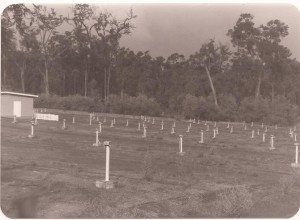
Bridgetown Drive In early 1980’s
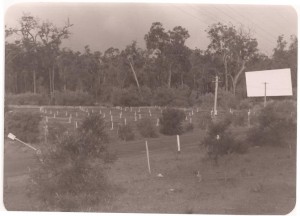
Bridgetown Drive In early 1980s
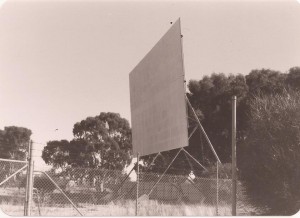
Bridgetown Drive In early 1980s
The Bridgetown Drive-in was built on shire land in the V-intersection of Les Woodhead Ave and the Bridgetown-Boyup Brook Rd. It opened in 1960 with a permit for 200 cars, and leased to Alan Larkin. As it served both Bridgetown (with a population of 2200 at that time) and Boyup Brook (with a population of 1899 at the time), eighteen miles away, screenings in halls in both these townships ceased soon after the drive-in opened.
Bridgetown Drive-in had been closed for three months at the end of Larkin’s 20-year lease before Roy Mudge took on the lease: his first screening was The Boat on 31 December 1982. He screened there on Fridays and Tuesdays, closed it for ten months in 1983 after opening the Town Hall, then opened it again over the summer of 1983-4. The drive-in was finally closed on 27 January 1985: it never re-opened and was eventually demolished and the site used as a BMX track.
Sources: Film Weekly Directory 1961/2 – 1971
Public Health Department, building permit, Battye 1459
Max Bell, Perth, a cinema history, The Book Guild Ltd, Lewes, Sussex 1986, p.131
Max Bell, Kino, no.52, June 1995, p.31
Interview (Ina Bertrand): Alan Larkin (1985), Roy Mudge (1997) Photos ; 3 exterior sepia, 1980’s ,Max Bell 2 exterior colour , 1988, Roy Mudge
MECHANICS INSTITUTE/ BRIDGETOWN TOWN HALL, Hampton St, Bridgetown
The Municipal Heritage Inventory describes the Town Hall complex:
The town hall was constructed on the site of the previous Mechanics Institute constructed in 1877 of local bricks with a shingled roof. This building was extended in 1908 to include a reading room and library… The Mechanics Institute was demolished in 1932 to make way for the new Town Hall which was opened in 1935 by Mr A. Doust. The Town Hall consisted of a hall, board offices, lesser hall, ladies rest room and banking chambers occupied by the Commonwealth Bank, and cost 7,000 pounds to construct. The Commonwealth bank moved out of the building in 1964.
In 1990 the building was remodelled and extended. The extensions included the addition of an upper floor on the Hampton Street elevation and alterations to the administrative areas of the building. The extensions designed by Lynne Sheen and Associates complements the original building with similar detailing and finishes. The original entry to the building had been closed.
The Town Hall is a two storeyed rendered brick building with face brick detailing which addresses the Hampton, Steere Street corner in the centre of Bridgetown. The style of the building is typical of the inter-war period with an emphasis on the horizontal in the external form and detail of the building.
The Mechanics Institute was the venue for early film screenings. Bridgetown was visited by the Salvationa Army Biorama Company in October 1904, and was one of the towns visited in 1906 by Heller’s Mahatma Company, from India, mostly screening Boer War films. In August 1907 and again in 1909, the Corrick family visited, with Leonard’s Beautiful Pictures. Films were screened intermittently over the years, but by the sound period in the thirties there was a regular weekly screening by a local operator (A.Jefferies?).
In 1939 Goldfields Pictures (founded in 1933 in Kalgoorlie) bought out the local operators and established a circuit, which included Harvey, Donnybrook, Bridgetown, Greenbushes and Boyup Brook, using a program sent out from Bunbury by manager Ron Elsegood and switched among the five venues. A resident operator (A.Jefferies?) screened in Bridgetown two nights per week.
In 1947, Alan Larkin bought the Bridgetown and Harvey picture businesses from Goldfields, converted them to Cinemascope and was screening two or three nights per week, commuting each week from Perth. The Film Weekly Directory lists Goldfields returning in 1962 and opening a gardens which lasted only two years. When these screenings ceased after the drive-in opened in 1960, the projection equipment remained in the bio-box in the hall for twenty years, because there was no market for secondhand apparatus in the wake of the collapse of film exhibition throughout the state.
Roy Mudge re-opened regular weekly screenings at Bridgetown Town Hall on 16 May 1983, starting with The Slipper and the Rose. Screenings were on Friday nights till Mudge also re-opened at Katanning, and after that the Bridgetown screenings were on Sunday nights. These weekly screenings ceased on 22 June 1985, and Mudge resumed screenings on 10 December 1994, with Lion King, continuing every three weeks till 14 July 1996 (the last film in this series was Dunstan checks in). Steve Marvin of Suburban Theatres then took on the venue and in 1997 was screening there irregularly, but this has now ceased.
Sources: Film Weekly Directory 1940/41 – 1964/5 Shire of Bridgetown/ Greenbushes, Municipal Heritage Inventory, HCWA No.12 0249 . Office Directory 1924-1949 Max Bell, Perth, a cinema history, The Book Guild Ltd, Lewes, Sussex 1986, p.103
Interviews (Ina Bertrand): Ron Elsegood (1985), Alan Larkin (1985), Roy Mudge (1997) Informant: Tony C.Paulsen (2002) Photos: 2 exteriors, colour, 1997, Graeme Bertrand
BROOKTON
BROOKTON DISTRICT MEMORIAL HALL,Whittington St, Brookton
The first Brookton hall was built on the north side of Whittington St, east of the White St corner. A second hall was then built on the west side of this, parallel with Whittington St. Finally, a still larger hall was built right up to the north-east corner of the intersection: the foundation stone for this final structure is dated 9 May 1956. The first hall became a general purpose room, the second became known as the Lesser Hall.
It was probably the first hall which was used by the Corricks when they stopped at Brookton, in November 1909. The second was visited by Columbia Talkies around 1940, and it and also the final building would have been used by Paddy Baker when the town was on his circuit, from the early forties to the late sixties.
Sources: Film Weekly Directory 1940/41, 1942/3 – 1966/7
West Australian 1909
Informant: Norman Apthorp (Brookton 1997) Photo: 1 exterior, colour, 1997, Graeme Bertrand
BROOME
SUN PICTURE GARDENS, Carnarvon St, Broome
There are more photographs and drawings and paintings of this venue than of any other in the state. In the Broome Museum (in the old Customs House) there are many relics of the theatre, including one of the original cast iron and wooden ceiling fans, glass advertising slides, wooden ticket dispensers and (most important of all) the original architect’s drawings in 1916. There is also a great deal written about it. The whole story is told in a small booklet available for $5 in all the tourist outlets of Broome: Maria Mann, Reflections of the Sun: a short history of the Sun Picture Gardens, Sun Pictures (Broome 1991). This story is summarised below.
The first regular screenings in Broome began at the Roebuck Hotel and the Continental Gardens Hotel, screening in alternate weeks until the rival operators had a falling out. Then in 1916 Sun Pictures was built for Ted Hunter, who had bought from the Yamasaki family a mixed business in Chinatown. Architect Lance Burton of Oldham, Boas and Ednie-Brown, prepared the plans, suitable for the tropical climate. The ‘shopfront’ appearance was retained, with a double hip roof above a long verandah on the street front. Behind was a simple ‘tin shed’, with the rear wall permanently open, so that the front half of the venue (closest to the street) was under cover and the rear section (closest to the screen) was open to the stars. It could hold nearly 600, and was often full. The cane chairs in the centre were reserved for the most important people of the town, with wooden bench seats for the rest, and careful racial segregation was maintained till 1967. Till 1930, movie patrons could ride the train from the Customs House to town for the movies.
In the first half of the twentieth century, the ports were the largest population centres in the far north of the state, and the natural places for cinemas to open. By the thirties, the State ships that went regularly up the coast carried films as deck cargo, packed in 40 gallon drums, delivering first to Carnarvon, then to Hedland, Broome and Derby. On a regular run, the films would be away from Perth for five months. In the fifties, Exmouth was added to this run.
In 1924, the Sun Pictures business was sold to Harry Milner and Leonard Knight, and the management was later taken over by Milner’s eldest son Jim. Milner and Knight added a mobile stage, which could be rolled in for live shows, including local school concerts as well as the occasional visiting performance. In 1948, the premises were bought by Mr and Mrs Walter James Anderson, and in 1953 by Alf Morgan, who leased them to Jean and Peter Haynes. Their daughter June Haynes writing in 1984, describes how, until a levee bank was built by the Shire, the King Tides would flood the main street of the town three times a year, so that patrons who walked in to the cinema would find that they had to wade out, or be carried out piggy-back to higher ground. This, and the effects of salt air and battering by cyclones, led to major repairs to the structure, but without much change to its appearance. She also remembers with affection -the beautiful marble soda fountain and a confectionery bar in the foyer’, which -became redundant as trade built up in Carnarvon Street.’
In July 1981, the Haynes family reluctantly closed the cinema, and put it up for sale. It was closed for some months before being bought by Lord Alistair McAlpine in 1982, and re-opened in 1983. There were a number of lessees during this period, none staying for very long. McAlpine’s chauffeur on his buying spree in Broome was a young Tony Hutchinson, who then returned to Perth to study Real Estate and came back to Broome in 1987 to begin work both in Real Estate and as projectionist at the Sun Pictures. In 1987 he bought the business from McAlpine with his fiancee Marisa Ferraz, and the two continued to operate the picture show while Hutchinson also worked as a Real Estate agent. By 1988 the cinema was screening seven nights a week and advertising as -the world’s oldest operating picture garden.
In 2000, it is still screening nightly, usually with two sessions each night. Old equipment and posters are on display in the foyer and around the entrance. So, the best way to find out about Sun Pictures is to visit it: it is well-patronised by both the tourists and the locals. In 1995 the cinema was nominated for the WA Register of Historic Places, and the planned renovations are intended to preserve its heritage value. It continued to operate after the new twin cinema was built, and is – and hopefully will remain – an important part of the state’s movie history.
Sources: The Heritage of Western Australia: the Illustrated Register of the National Estate, Macmillan 1989, p.128
Film Weekly Directory 1940/41 – 1971
Kino no.6, December 1983, p.17; no.46, December 1993, p.30; no.53, September 1995, p.31; no.80, Winter 2002, p.54
Post Office Directory, 1917 – 1949
Ina Bertrand, �Going to the pictures in the Kimberley�, part 3, Kino 74, Summer 2000, pp.39-41
Colin Bowles, Nights in the Sun Penguin 2003 (This is a work of fiction, based around the Sun Picture Gardens and the town of Broome as it was in 1926)
Bill Bresser, Broome Reflected: pencil sketches of Broome, BJ Publications, Canberra 1986, p.4
Raymond Gill, �Cinema among the bougainvillea’, Age, Melbourne, 2 October 1993
Jean Haynes, unpublished reminiscences
Jean Haynes, Kevin Lawton, �The oldest operating picture gardens in the world: Sun Pictures’,Shire of Broome Community Information Directory 1987-88
Maria Mann, Reflections of the Sun: a short history of the Sun Picture Gardens, Sun Pictures, Broome 1991
Russell Scott, �The Sun always rises�, Kino, no.70, Summer 1999, pp.30-31
Stage, Screen and Stars, West Australian, n.d. (1997?), p.49
Interview (Ina Bertrand): Alan Larkin (1985)
Photos: 1 interior, b&w, 1928 Everyone’s, 27 June 1928, p.14
1 interior, b&w, 1930 (racially segregated audience), Battye 3680B (also in Stage, Screen and Stars, West Australian, n.d. (1997?), p.49)
1 interior, b&w, 1953 (section of audience) Battye TB 764
1 interior, b&w, 1953 (section of audience, prams parked beside seats) Battye TB 765
1 exterior, b&w, 1983?, Kino no.6, p.17 (G.England, courtesy John Williams)
1 exterior (pencil sketch), 1986, Bill Bresser, Broome Reflected: pencil sketches of Broome, BJ Publications, Canberra 1986, p.4
1 interior (ticket box), colour, 1988 (Margot Tucker)
1 interior (screen & seating), colour, 1988 (Margot Tucker)
3 interior (seating and biobox), colour, 1988 (Margot Tucker)
1 exterior, colour postcard, no date, copyright Northern Territory Souvenirs, photograph by Wayne Zerbe
2 exterior, colour, 1988 (Bill Turner)
2 exterior, colour, 1988 (Margot Tucker)
1 exterior (night), colour, 1988 (Margot Tucker)
1 exterior, b&w, n.d., The Heritage of Western Australia: the Illustrated Register of the National Estate, Macmillan 1989, p.126
1 exterior, colour, 1994 (Robert Newton)
2 interior (seating and screen), colour, 1994 (Robert Newton)
1 exterior, colour, 1999 (Graeme Bertrand)
3 interiors, colour, 1999 (Graeme Bertrand). 1 exterior Max Bell 1980’s
BROOMEHILL
BROOMEHILL HALL/ MECHANICS INSTITUTE, Journal St, Broomehill
The Broomehill Hall was built on the southern corner of Jasper St, but facing Journal St. It was completed on 20 April 1898, and was opened with a ball on 1 July 1898. It was a small brick building with an iron roof, used for many community activities, and later known as the Mechanics Institute. It was the only hall in the town till about 1910, so till then any films in the town must have been shown there. It was consecrated as a church in 1929 and became the town museum in 1979.
Sources: Film Weekly Directory 1950/51 – 1951/2
Shire of Broomehill, Municipal Inventory
Informant: S.MacDonald (1997)
Photos: 2 exteriors, b&w, n.d., Shire of Broomehill, Municipal Inventory
2 interiors, b&w, n.d., Shire of Broomehill, Municipal Inventory
1 exterior, b&w, 1997, Graeme Bertrand
SHERIDAN’S HALL/ TOWN HALL, Jasper St, Broomehill
This hall was built about 1910, on the southern side of Jasper St, in the middle of the block west of Journal St. It was at first known as Sheridan’s Hall:
This galvanised iron hall was built for Mrs Kathleen Sheridan (Imperial Hotel licensee) by George Green. It was used as a skating rink as well as a hall. The brick front was added in 1928 for the Broome Hill Road Board as offices and a boardroom. (Municipal Inventory)
It may have been here that Tivoli Pictures presented their films in Broomehill on 18 June 1914. There is a bio-box in the hall and local people still remember pictures there from the twenties to the late forties. One member of the Historical Society remembers being taken to see “Uncle Tom’s Cabin” about 1926, but she cried so piteously that she was taken outside. Frank Greenslade remembers Star Talkies in the Broomehill Town Hall once a month in 1937/8 when he was a boy. He says the red truck would drive into town and the boys would rush to be first to be given the task of washing the vehicle, in return for a free ticket to the pictures. The screenings by the Kanzlers were also probably here, when the town was on their circuit around 1950.
Sources: Film Weekly Directory 1950/51 – 1951/2 Frank Greenslade (at Maylands Historical Society, July 1997)
Shire of Broomehill, Municipal Inventory
Great Southern Herald, 13 June 1914
Photos: Shire of Broomehill, Municipal Inventory .
1 exterior, colour, 1997, Graeme Bertrand
BRUCE ROCK
DURHAM HALL, Johnson St, Bruce Rock
The first hall in Bruce Rock was opened 25 July 1917, but was quickly outgrown and replaced by a new hall, opened 28 July 1920. The brick offices in front were replaced with a new two-storey frontage, opened 5 January 1929.
The Durham Hall stands prominently in Johnson St, only one building block south of the junction with Parry St, and next to the hotel of which it seems to have been a part. It is a stone building, with a corrugated iron roof, and the bio-box is still visible inside.
In 1921, West’s Touring Pictures visited the town. In 1928 Athol Pearmine was screening at Bruce Rock. From 1929 to 1949 the business was operated by Stanley Lonsdale and later by his widow Mrs H.M.Lonsdale, then Stanley Lonsdale jnr. The hall held two hundred, and screenings were offered once or twice a week, except for a short period after it burned down on 7 January 1937: the hall was rebuilt and screenings continued into the sixties.
In 1997 Durham Hall was in use as a restaurant, and no-one could remember how long ago films were last screened there.
Sources: Film Weekly Directory 1940/41 – 1964/5
Post Office Directory 1929-49
Max Bell, Kino, no.46, December 1993, p.30
Max Bell, Perth – a cinema history, The Book Guild, Lewes, Sussex, 1986, p.103
John K. Ewers. Bruce Rock: the story of a district, Bruce Rock District Road Board 1959, p.48
Everyone’s 7 March 1928, p.18
Photo: 1 exterior (Road Board offices and hall), John K. Ewers. Bruce Rock: the story of a district, Bruce Rock District Road Board 1959, Plate XXII
1 exterior (Durham Hall), colour, 1997, Graeme Bertrand . 1 Exterior , Max Bell no date.
ROCKVIEW DRIVE-IN, Noonajin Rd, Bruce Rock
This small drive-in opened in 1964, on the southern side of Noonajin St, opposite where Johnson and Butcher Sts meet Noonajin St. It was operated by Stanley Lonsdale jnr, and had a capacity for 155 cars at first, later increased to 208, with a section for seated patrons:
Council borrowed a $24,000 self-supporting loan to enable Mr Lonsdale to build the theatre but unfortunately he was forced to abandon the project in 1977 because of a fall off in patronage due to newly constructed theatres in neighbouring towns.
Council then took over the running of the theatre for twelve months before leasing it to G.F.Ford of Merredin who carried on with the operating until the screen was destroyed by a bad storm in early 1981.
As patronage had dwindled to a large extent and the theatre was uneconomic it was decided not to replace the screen and to close the drive-in. The only activity at the drive-in since closure was a tractor-pull demonstration organised by the Bruce Rock Apex Club in 21 July 1981 which raised $16,000 for a local indoor recreation centre project. (Bell, p.132)
In 1997 the road entry and ticket box were still standing, but the site was a private residence.
Sources: Film Weekly Directory 1964/5 – 1971 Public Health Department, building permit, Battye 1459
Max Bell, Perth – a cinema history, The Book Guild ,Lewes, Sussex, 1986, p.131-2
Merredin Mercury (check before Nov.1965)
Interview (Ina Bertrand): Alan Larkin (1985)
Photos; 3 exterior, colour, 1987, Roy Mudge
BRUNSWICK JUNCTION
MEMORIAL HALL, Ridley St, Brunswick Junction
The Brunswick Memorial Hall is constructed on the corner of Ridley St and the highway, with the main and lesser halls facing Ridley St and an entrance named Memorial Hall on the highway. There seem to be three halls here, and the middle one (the one with the bio-box) is dated 1936.
The town was on the Kanzler’s circuit out of Albany in the forties, on Allan Jones’ circuit out of Busselton in the fifties, and on A.H.Jeffries’ South West Pictures circuit in the early sixties. In the middle sixties, John Marsden started screening there. He was working six nights a week at the Mayfair, Bunbury, and had been screening on Sunday nights in Capel Town Hall for a year when he decided to shift these screenings to Brunswick Junction. At first he screened every Sunday night, then he opened also in Dwellingup and alternated Sunday nights in the two towns, continuing even after he moved back to Perth to screen at the Windsor, Nedlands.
It is not clear whether anyone else screened at Brunswick Junction after Marsden left.
Sources: Film Weekly Directory , 1940/41 – 1964/5
Interview (Ina Bertrand): John Marsden (1997) Photo: 1 exterior, colour, 1997, Graeme Bertrand
BULLFINCH
HALL AND GARDENS, Bullfinch
Max Bell (p.103) says:
Operated by R.Morris and N.V.McDougall, the Bullfinch, opened in late 1940s. Seating capacity of indoor cinema was for 350 patrons on one level. Seating capacity for the adjoining gardens was the same but with canvas deckchairs. The venue ceased operating in 1965.
The Film Weekly Directory suggests that S.Bennett’s Columbia Talkies may have screened here in the thirties. By the late forties, there was a gardens as well as the hall, and the town was on Morris’s circuit out of Marvel Loch, and this continued till the middle sixties, when it was taken over by Stanley Lonsdale junior, who continued till screenings ceased in 1965.
Sources: Film Weekly Directory 1940/41, 1948/9 – 1964/5
Max Bell, Perth – a cinema history, The Book Guild, Lewes, Sussex, 1986, p.103
BULLSBROOK
HALL, Pearce RAAF Base, Bullsbrook
Valma Martin remembers:
“Outsiders” (people other than RAAF personnel) who lived nearby could attend pictures on the base. You only had to slow down at the gate and were waved through in your vehicle. You parked near the theatre, which was small, probably held about 100. This was early 1950s.
The Pearce RAAF Base hall was listed as holding 300, in the Film Weekly Directory of 1971.
Sources: Film Weekly Directory 1971
Informant: Valma Martin (Swan View 1997)
OPEN AIR PICTURES, Bullsbrook
Ruth Talbot remembers that Mr Angel of Bullsbrook used to show pictures in the open at the Bullsbrook school in the early 1950s.
Sources: Informant: Valma Martin (Swan View 1997)
BUNBURY
BEDFORD HALL/ EMPIRE THEATRE/ HALL, Bunbury
The foundation stone of the Bedford Hall is now held in the King Cottage Museum. It records the opening of the building on 27 September 1906 by Sir Frederick Bedford.
It is not clear where films were screened in the town before that date, but Bunbury was the major location for companies touring the southwest from very early in the century. The Payne Family Concert and Cinematograph Co presented films of the Boer War in Bunbury for two nights as early as May 1900, with great success. The Salvation Army Biorama Company visited the town in October 1900, August 1902, January 1904 and October 1904.
After the Lyric opened in 1905 and the Bedford Hall in 1906 the touring companies continued to come, and the advertisements do not always make clear where they held their screenings. So Heller’s Mahatma Company, from India, but screening mostly Boer War films still, toured the area later in 1906, stopping for a night or two in Bunbury among others in July 1907. A month later, the Corrick family, with Leonard’s Beautiful Pictures, came through Bunbury, and made a return visit on their way back to Perth. They visited again in 1909. Edison’s Popular Pictures reached Bunbury in August 1908, and Moore’s Marvellous Moving Pictures arrived only a month later. The tour of the Musical All-Blacks brought them to Bunbury in April and September 1908. Vic’s Pictures also visited Bunbury regularly for some time in the following years. All of these may have been in the Bedford Hall, though that is not certain.
In November 1910, Spencer’s Pictures were presented by the Gaiety Picture Co, definitely in the Bedford Hall. On 30 December 1918, local entrepreneur Gunning (Spot) Davis opened the converted Bedford Hall as the Empire Theatre. A mixed programme of pictures and vaudeville was presented there up to three times a week until at least March 1919. It is not clear what happened to this venture – but Davis left Australia in 1920 to tour America with a four-legged chicken, so if the Empire continued it was probably under the direction of someone else.
The hall was demolished.
Sources: South Western Herald 1906-1918
South West Times 16 April 1997
EMPIRE PICTURE GARDENS, Wellington St, Bunbury
On 12 February 1911, the first purpose-built cinema in Bunbury was opened next to the Rose Hotel in Wellington St. The local paper commented:
The gardens, newly-formed though they be, are exceedingly pretty and comfortably appointed. (Bunbury Herald 9 February 1911 p.3)
J.B.O’Neill directed the proceedings, screening International Pictures from the J.D.Williams Co, every night over the summer months. The Gardens opened again over the summers of 1912-13 and 1913-14, but was not advertised after this, though it was listed in the Post Office Directory in 1920.
Sources: Post Office Directory 1920 Bunbury Herald 9 February 1911 p.3
South Western Herald 1910-1919
ENTERTAINMENT CENTRE
This large complex is primarily a live venue, for concerts and theatrical performances. It was built in 1990 by the City of Bunbury, at a cost of $5.5million, funded by endowment lands. Continuing funding for the Centre’s operation is provided by the City, with assistance from state government grants: in 1997 there was some controversy over whether this funding was sufficient and why the state government could not find the additional $100,000 per annum required to keep the venture solvent.
At that time, films were screened there from Thursday to Sunday each week, mainly arthouse product. The programming policy differed from the commercial fare at the Grand Cinemas next door, but was in competition with it nonetheless, and that competition was blamed for the difficulty the complex had in keeping afloat.
Sources: Anthony J.Barker & Maxine Laurie, Excellent connections: a history of Bunbury, Western Australia, 1836-1990 , City of Bunbury 1992
Informant: Barry Lee (1997)
FORREST THEATRE & GARDENS, Spencer St, Carey Park, Bunbury
Goldfields Pictures had a monopoly of cinema in Bunbury in 1951, when Mr Arthur Dunn, a former employee of Goldfields, opened the Forrest Theatre, in Spencer St, Carey Park on 14 December. This was a small hardtop cinema, designed by R.M.Neal and Allen, with provision for around 500 patrons. It was described in the South Western Times as ´modern in conception both inside and out’ (13 December 1951), with modern lighting, comfortable chairs, and – most innovative of all – a crying room. In 1954, a gardens was added alongside.
When Dunn and Ace Theatres opened the Forrest Drive-in, in September 1963, the Forrest Theatre closed. The Forrest Gardens lasted one more summer season, then it too was closed, and a BP service station was built on the site.
Sources: Film Weekly Directory 1952/3 – 1964/5
Public Health Department, building permit, Battye 1459
Max Bell, Perth, a cinema history, The Book Guild Ltd, Lewes, Sussex 1986, p.109
South Western Times 13 December 1951
Photos: South Western Times 13 December 1951
GRAND CINEMAS, Victoria St, Bunbury
Jimmy Stiles’ Grand Theatre Co had been a force to be reckoned with in the thirties in Perth city and suburbs. Later the company became City Theatres, was taken over by TVW7 and in 1988 the theatres were sold to Hoyts. But the Stiles family retained their interest in moving pictures, and in the nineties formed a new Grand Theatre Co and opened the Warwick 8 in suburban Perth.
Their second venture, this time in partnership with the Key West group, was a multi-plex in Bunbury on a site bounded by Victoria St, Blair St and Clifton St. The main entry was on Victoria St, but an equally imposing facade along Blair St echoed the pillars and rounded lines of the Entertainment Centre next door. The complex opened on 22 November 1996, with four cinemas – two holding 188 and two holding 238. All were equipped with the latest digital sound, were very modern in design, and provided wheelchair access.
They screen seven days a week, with daytime as well as evening screenings, and at least one new film each week. In 1997 the manager was Barry Lee, who began his career at Cinema City, Perth. In 1998, plans were announced to add a further two cinemas, each holding 193 patrons.
Sources: Kino, no.56, June 1996, p.31; no.59, March 1997, p.31; no.62, Summer 1997, p.35; no.66, Summer 1998, p.30.
Informants: Barry Lee (1997), Arthur Stiles (1998)
Photo: 1 exterior (Blair St facade), colour, 1997, Graeme Bertrand
LYRIC, Victoria St, Bunbury
Local halls were usually multi-purpose venues. The earliest real theatre in the area was Bunbury’s Lyric Theatre, built on the south-west corner of the intersection of Victoria and Symons Sts for the Weiss Brothers in 1905:
The arrangement of the building consists of a principal entrance from Victoria St, which is obtained through a spacious vestibule with tiled floor. Through a handsome pair of wrought-iron gates access is given to the ticket office and staircase hall, while flanking the sides of vestibule are two large shops. Immediately opposite the vestibule is the entrance to the hall, which latter strikes one as being finely proportioned. Its dimensions are 72ft long by a width of 49ft, and from the floor to the highest point of the ceiling 28ft. Extending round the sides and at the back of the hall is a gallery, the supporting pillars of which are so arranged as to secure an uninterrupted view of the stage, as well as forming the least possible encroachment on the dancing space. The gallery is reached by a broad staircase leading up from the left of the principal entrance, and has seating accommodation for 250 persons. The view of the stage from all parts of the gallery is uninterrupted; in fact the best seats in the hall so far as the stage view is concerned are on the back gallery. Special attention has been given to ventilation. The whole of the cove at the intersection of the ceiling and the wall is battened, and forms a ventilating shaft, while four exhaust shafts have been provided in the ceiling. The lighting in the hall is by means of eight large semi-circular windows, which give a good light and provide a striking feature. The roof is of iron, the constructional parts of which are exposed. Leading from the stairs and before entering the gallery, is a large crush hall, from which entrance is obtained to the cloakroom and to a lounge or refreshment room, which has a balcony spanning the footpath over the main entrance to the theatre. By the same means the asphalted roof gardens over the two shops are approached, on which it is proposed to place seats and provide ornamentation with pots, ferns etc. These pleasant lounges are sure to be much appreciated. The bold moulded proscenium opening measures 20 x 18, and the stage, which is provided with galleries and gridiron for fixing and manipulating the scenery, measures 40 x 20 feet… (Bunbury Herald, 3 April 1905)
Stage and backstage facilities were provided on a level quite lavish for a provincial theatre, and it was obviously intended to be the venue for visiting companies as well as for local dramatic groups, dances and other community occasions. Local resident Verna Glossik recalls that Paddy Doyle used to play the pianola there.
Though not specifically built to screen films, it was obviously ideally suited for this purpose, and was soon in demand from travelling showmen. In April 1909, King’s Pictures began a weekly circuit that brought their programmes to the Lyric every Thursday and a month later, West’s initiated a similar circuit, which screened in the Lyric every Monday till August 1912 when they shifted to Thursday.
In 1923 the Princess opened, but the Lyric, bought by A.D.Swanson in 1926, continued to screen films, and for some time the competition was so fierce that both the Lyric and the Princess spent large sums on advertising in the local paper, in ever more lavish displays, and in employing vaudeville artists to outshine their rivals. This was clearly not a viable situation for either management, and in 1933 Swanson bought the Princess lease and for a short time ran both venues. In 1936, however, he sold out to Nelsons, who at first also continued with both theatres. Though the older of the two, the Lyric was the prestige venue – the one with the superior Western Electric sound equipment (installed in 1929), with the best programmes from the largest Hollywood studios, and with the occasional high-class supporting live entertainment. However, on 1 April 1937 a fire severely damaged the front section and the rear was affected by smoke and water.
It was then remodelled to a design of William Leighton, turning it from an all-purpose building into a purpose-built cinema. The stage was removed, the proscenium enlarged, and additional seating provided in the stalls in the extra space thus opened up. The pillars holding the gallery were removed, and girders were added to take the weight of the upstairs section. The wings of the gallery were demolished, and the rest of the gallery turned into a sloping dress circle. The windows, praised when first constructed, were now described as ´unsightly’, and were replaced with plaster grilles, to ensure the continuation of the ventilation they provided, but in a manner more aesthetically pleasing to thirties’ tastes. The whole interior was repainted and refurnished, including carpets in the lounge foyer. Outside, the alterations were equally dramatic. The verandah was replaced with a cantilever structure, the facade modernised and simplified, the entrance provided with swinging glass doors with chromium fittings, and the shopfronts altered in keeping with the general design. The turret tower, however, was retained, and was used to hold the new neon sign for the cinema.
The New Lyric opened with Sonja Henie in Girl in a Million on 6 July 1937, but later that year both the Lyric and the Mayfair were bought from Nelsons by Goldfields Pictures. They turned the Princess into a dance hall at first, then, despite the recent re-fitting of the Lyric, they decided that a more modern theatre was warranted in the town. The Lyric continued to screen, while the Princess was demolished to make way for the spectacular Mayfair Theatre, which opened on Friday 4 August, 1939.
The Lyric closed in December 1939, was first leased to Colin Smith as a dance hall, then converted into shops, and was sold by Goldfields in 1946. In the fifties the building was used as a dance hall, and in the eighties and nineties by Browns Furniture: the structure is still clearly visible, from both inside and outside.
Sources: Max Bell, Perth, a cinema history, The Book Guild Ltd, Lewes, Sussex 1986, p.113
Vyonne Geneve, ´William Leighton, architect’, Kino, no.25, September 1988, p.12
Jenny Staines, ´The Lyric Theatre down through the ages’, typescript, 1987>
Verna Glossik to A.E.Wiliams, June 1985
Bunbury Herald 3 April 1905
South Western Times 3 July 1937
Interviews (Colleen Pead): Ron Elsegood (1986), Jack Everett (1986)>
Photos: 1 exterior, b&w, 1938 (Ron Elsegood)
1 exterior, colour, 1985 (Robert Newton)
1 exterior, b&w, 1986, Kino no.25, September 1988, p.10 (Byron Geneve)
MAYFAIR DRIVE-IN, Vittoria Rd, Glen Iris, Bunbury
The Mayfair Drive-in, designed by Kenneth Broadhurst for Goldfields Pictures in Glen Iris, a suburb of Bunbury, opened on the 9 December 1958, with The Girl in the Red Velvet Swing. Drive-ins were so new that it was thought necessary to educate people about what to expect. The public was invited to ´Come as you are in the family car’. A four-page supplement in the local paper provided an introduction to every aspect of the new premises:
Orthodox theatres take film entertainment into the families. Drive-ins bring family life into the theatres.
In your own car, in whatever clothes you wish to wear, and in complete privacy, you can enjoy the same films you would see at any theatre. As with any drive-in, Bunbury’s Mayfair provides each car with an internal speaker so that the complete soundtrack comes to you clearly and uninterrupted.
The Mayfair’s giant screen ensures that each carload of patrons receives a perfect view of the pictures, and the entire parking area is scientifically ramped to place each car in a position from which the screen is perfectly visible…
Here, at the Mayfair Drive-in, a novel and pleasing feature is possible – modern entertainment in homely comfort, with the unsurpassable background of the Australian bush at night. (South Western Times 4 December 1958)
The venue held 300 cars when it first opened, but was soon enlarged to 400. In 1985, Goldfields no longer ran their drive-in themselves, but leased it and were looking for a buyer. It was then purchased by the Grace Christian Centre Apostolic Church for use as a school site: the ticket box and entry road were incorporated into the school grounds, and the screen still looked down on the playing fields till it was demolished, late in 1998.
Sources: Film Weekly Directory 1959/60 – 1971
Public Heath Department, building permit, Batty 1459
Max Bell, Perth, a cinema history, The Book Guild Ltd, Lewes, Sussex 1986, p.137
Kino, no.29, September 1989, p.23; no.66, Summer 1998, p.30.
South Western Times 4 December 1958
Interview (Ina Bertrand): Ron Elsegood (1985)
Photos: 1 exterior, entrance, colour, 1985, Robert Newton
2 exteriors (ramps and screen, children’s play area) South Western Times 4 December 1958
PRINCESS/ MAYFAIR, Stephen St, Bunbury
The Princess was built for local entrepreneur (and at that time Mayor of Bunbury) J. (Jack) Hands, on the south side of Stephen St, and opened on 31 October 1923, with seating for one thousand people:
There are no posts in the theatre, so that all can have the same view of the pictures without any interruption whatever.
The operating box is probably unique in Western Australia. It is absolutely fireproof, being built of re-inforced concrete, in sliding panels to automatically shut instantaneously at a moment’s notice. The operating machine itself is the latest Simplex model and has evoked the warmest praise from cinema experts all over the world. It can be driven by motor or by hand.
The advertising machine is a separate instrument, so as to ensure to advertisers the best possible value for their announcements, some of which, by the way, are quite novel for this part of the state.
The lighting of the theatre is controlled from the operating box besides, independently, whilst owing to a special arrangement, the supply of electric current is continuously assured – only limited by a complete breakdown at the same time in the municipal lighting system.
As to the risk of fire, besides the absolute fireproof construction of the operating box, there are five exits from the building – more than required under the regulations governing this matter at places of public entertainment. (Bunbury Herald and Blackwood Express, 30 October 1923)
Clearly, since the opening of the Lyric nearly twenty years earlier, the needs of film had been recognised as being specific and rather different from the needs of legitimate theatre. Nevertheless, the Lyric, bought by A.D.Swanson in 1926, continued to screen films in competition with the Princess, and for some time that competition was so fierce that each spent large sums on advertising in the local paper, in ever more lavish displays, and in employing vaudeville artists to outshine their rivals. This was clearly not a viable situation for either management, and in 1933 Swanson bought the Princess lease and for a short time ran both venues. In 1936, however, he sold out to Nelsons, who at first also continued with both theatres.
When the New Lyric opened in 1937, the Princess ceased showing films, and was turned into a dance hall. In 1939, both leases were bought from Nelsons by Goldfields Pictures, and despite the comparatively recent re-fitting of the Lyric, they decided that a more modern theatre was warranted in the town. The Lyric continued to screen, while the Princess was demolished to make way for the spectacular Mayfair Theatre, which opened on Friday 4 August, 1939.
The Souvenir Programme of the Gala Opening of the Mayfair was as extravagant in its claims for the theatre as those issued for the opening of city venues:
…In the construction of the Mayfair Theatre the first consideration has been for the comfort and convenience of patrons, and we feel that not only has this been accomplished but that we have been instrumental in having erected a building in the South-West which is more modern than in any provincial district throughout the Southern Hemisphere…
Taking twenty weeks in the construction, the Theatre is one of the largest buildings in the South-West and is capable of seating 1200 persons.
Three hundred and sixty yards of sand, 150 tons of metal, 50 tons of steel and 85 tons of cement were used in the reinforced concrete work in the building while 204 thousand bricks were required to build the walls.
The entire interior of the building has been lighted with Neon tubing and this is the first theatre in a provincial town in Australia to be so treated. Altogether more than 2,000 feet of Neon tubing were utilised….
With the ceilings painted in shades of autumn tints the effect of this Neon lighting is a sight to behold. Constructed in strips the length of the ceiling the tubing exudes its soft light over the whole of the interior, picking up and reflecting the autumn tinted colour scheme…
…provision has been made for large sections of the wall to be opened to allow of free access of the sea breezes which are a feature of the summer evenings in Bunbury.
Large roller shutters have been built into the walls of the theatre to cover these apertures in the winter, but during the warmer weather they can be rolled up into a recess near the ceiling…
We feel confident that this ´natural air conditioning’ will meet with the immediate approval of all patrons…
All seats in the Lounge and Dress Circle are of padded Dunlopillo: the very latest in seating comfort. The seats are generously wide, with large sprung arms…
Commencing at the entrance to the main foyer carpets have been provided to cover the entire flooring of the staircases, lounge foyer, lounge and dress circle. In fact patrons of the dress circle and lounge will be on carpet from the time they enter the building till they depart.
It is clear from this description that the standards of comfort which by 1939 were simply taken for granted in city theatres and were standard even for most suburban theatres were still remarkable for the country patron. The management of the Mayfair did not intend to let the citizens of Bunbury forget that here was a theatre that could offer country people some of the luxury associated with the distant metropolis.
Even the outbreak of war only a month after the opening, though it required the blacking out of the windows, did not dim the fortunes of the theatre. In fact, when the town became a centre for U.S. marines on furlough, business boomed, sometimes to the chagrin of the locals. One evening some regular patrons were distressed to find that they could not obtain their usual seats because a marine had bought 55 seats – the whole back row – so that he could be alone with his girl.
Under the combined effects of television and the competition of two drive-in theatres (one of them their own) Goldfields closed the Mayfair Theatre in 1967, and when the lease expired in 1969, the property reverted to the Hands estate, and is now the site of the Commonwealth Bank.
Sources: Film Weekly Directory 1940/41 – 1966/7
Post Office Directory 1924-1949
Public Health Department, building permits, Battye 1459
Max Bell, Perth, a cinema history, The Book Guild Ltd, Lewes, Sussex 1986, pp.114-5
Mayfair souvenir programme , Friday 4 August 1939
Bunbury Herald and Blackwood Express, 30 October 1923
Interview (Ina Bertrand): Ron Elsegood (1985)
Interview (Colleen Pead): Jack Everett (1986)
Photos: 1 exterior, Mayfair 1938, b&w, Ron Elsegood
1 interior, foyer, opening night, Mayfair 1939, b&w, Ron Elsegood
BUNTINE
HALL
Buntine, 17km. north of Wubin on the Perenjori Rd, was on the Fitzgerald circuit around 1950, then on Lew Punch’s wheatbelt circuit till about 1959. As this was before the hall was built, these screenings may have been open air.
The hall, built in 1958, is large, with a rendered brick facade. In the late fifties, Vic Basham bought Neil McKee’s half interest in Ray Dean’s circuit, and continued to work the circuit with Dave Cox. After the partnership broke up, Basham continued to provide Buntine with fortnightly screenings, until drive-ins made screenings in the smaller towns uneconomic.
Sources: Film Weekly Directory 1950/51 – 1960/61
Interview (Ina Bertrand): Vic Basham (1997)
BURRUP
BURRUP Gardens
Photos, 4 colour, exterior, 1986, Roy Mudge
BUSSELTON
BARNARDS HALL/ (CONVENT HALL)/ BUSSELTON PICTURE GARDENS/ REGAL & GARDENS/ ALLAN CINEMA/ CINEMA 1, Albert St, Busselton
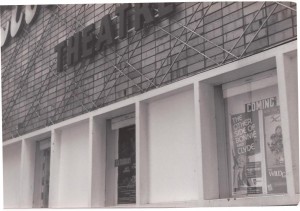
Busselton Allan Theatre 1980’s
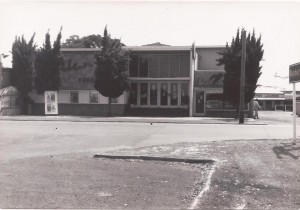
Busselton Allan Theatre 1980’s
- Busselton Allan Theatre 1980’s
In 1907, the Corrick family, with Leonard’s Beautiful Pictures, came through Busselton, and there were occasional films screened in those very early days by other touring companies, including the Salvation Army in October 1904. All these may have been held in Barnards Hall, which had been built about 1900 in Albert St, next to the Commercial Hotel which stood on the north-east corner of the intersection of Albert and Queen Streets.
The first regular film screenings may have been those of Jack Bignell (or was it Victor Kruger?), in the Dining Room of Bignell’s Esplanade Hotel. Bignell then began a weekly Saturday night screening in Barnards Hall. In the twenties, this venture was operated by G. L. (Gomer) Edwards, who renovated the hall, including the installation of a bio-box. But the venue was still rather primitive: seating was on 79 chairs and twelve backless forms, until additional seating arrived from Sydney in 1923. Edwards introduced sound films – first on disc, then sound-on-film.
This business, known as Regal Pictures, was bought out by Allan Jones in 1935. At the same time, Jones bought out Edwards’ competitor, who was screening at the Convent Hall. He amalgamated the two shows, continuing to screen in Barnard’s Hall, and re-negotiated contracts for the town.
Two years later Jones added the Busselton Picture Gardens, also on the north side of Albert St, but across the Queen St intersection. This had 350 seats, and ran during the summer in conjunction with the hall, which also had 350 seats. The whole enterprise was known within the trade as the Regal and Gardens. At the time, this was the only open air show in the south-west, as the weather was not as enticing here even in the summer months as it was in Perth and further north. But it was a real gardens, with deck chairs and trees and shrubs surrounding the seating area. In typical fashion with such seating, the canvas was likely to rot, and to let the patrons down unexpectedly: Jones learned to play the national anthem at the end of the programme, rather than at the beginning when he risked having all the patrons sitting down hard at the same moment as soon as it finished! Against all expectations, even of the locals, the gardens was quite successful.
Nevertheless, in April 1958 the gardens closed and in November 1958 the Allan Theatre opened on the gardens site and screenings ceased in the hall, which was demolished in 1969. As attendances dropped after television reached the district, Jones curtained off one side of the cinema as a display area for movie equipment and memorabilia, and opened it to the public as a museum. Attendance diminished during the seventies, and rowdiness became a problem among younger patrons.
When Allan Jones died in May 1982, his cinemas were taken over by a family company – Jones’ Cinewest Drive-ins. Though Allan had been the figurehead, the family had always been closely involved in the running of the cinemas – Mrs Jones managed the cinema in Busselton for more than thirty years, and two sons had worked with their father from as soon as they were able. The company continued to run the drive-ins at Busselton and Margaret River, as well as the cinema at Busselton, now known as Cinema 1.
In 1983 they curtained off the sides of the cinema right to the ceiling (not just halfway like the museum curtain), and installed Dolby stereo sound and new seating. The sound was again upgraded in 1995. Attendance revived slowly in the eighties and nineties till in 1997 the cinema was screening Friday to Sunday, and sometimes on Wednesday night all through the year, with many more screenings during school holidays, and many fund-raising screenings as well.
Sources: Film Weekly Directory 1940/41 – 1966/7
Public Health Department, building permit, Battye 1459
Max Bell, Perth, a cinema history, The Book Guild Ltd, Lewes, Sussex 1986, pp.95-98, 99, 101
´Chandem’, ´The cinema at Busselton’, Busselton Historical Society Newsletter, March 1967, vol.2, no.2
Allan Jones, Reminiscences of a Travelling Picture Showman , Busselton 1974
Interview (Ina Bertrand & Irma Whitford): Allan Jones (1978)
Limelight Picture Show Tours, http//:www.abc.net.au/limelight/docs/tours
Photos: 1 exterior, Barnard’s Regal Theatre 1940, b&w, Allan Jones, Reminiscences of a Travelling Picture Showman, Busselton 1974, p.12
1 exterior, Picture gardens 1939, b&w, Allan Jones, Reminiscences of a Travelling Picture Showman, Busselton 1974, p.12
1 exterior, Allan Theatre 1958, b&w, Allan Jones, Reminiscences of a Travelling Picture Showman, Busselton 1974, p.7
1 exterior, Cinema 1 1986, Kino no.19, p.12, Max Bell
1 interior of museum, Cinema 1 1986, Kino no.19, p.12, Max Bell>
1 exterior Cinema 1, 1985, colour, Robert Newton 3 exterior Max Bell 1980’s
BUSSELTON DRIVE-IN, Bussell Highway, Busselton
Allan Jones built a drive-in on the southern side of the Bussell Highway in the Busselton suburb of Broadlands, on the south-east corner of Bent Drive. It opened 17 December 1961, with provision for 150 cars, but was later enlarged (to 450?). When he died in 1982, his cinemas were taken over by a family company – Jones’ Cinewest Drive-ins, which continued to run the drive-in.
In 1997 it was operating in the summer months, screening every night in warm weather and school holidays, then tapering off as the weather gets colder. The gardens were still trim, and FM stereo sound was introduced in the summer of 1996-7, though the speakers had been retained in case any car had no radio or had trouble with it.
Attendance was improving, particularly among the tourists. The snackbar was refurbished in 1996 and in the summer of 1997-8 it opened for tea before the show because the previous season cars were lining up outside well before opening time. More families were coming by then, so the management deliberately programmed family films: the back rows where the young people used to gather were by then usually empty.
This drive-in was successful, but its future was not assured: in 1997 there were plans to replace it with a multiplex some time in the future.
Sources: Film Weekly Directory 1961/2 – 1971
Public Health Department, building permit, Battye 14592
Max Bell, Perth, a cinema history, The Book Guild Ltd, Lews, Sussex 1986, pp.132
Allan Jones, Reminiscences of a Travelling Picture Showman, Busselton 1974
Film Weekly, 5 January 1961, p.7
Interview (Ina Bertrand & Irma Whitford): Allan Jones (1978)
Informant: Ron Jones (Busselton, September 1997)
Photos: 3 exterior (entrance gates and billboards) , colour 1985, Robert Newton 3 exterior Max Bell 1980’s
BYFORD
BYFORD PICTURES, Byford
Byford was a small country town when Roch Evans’ Modern Cinemas circuit visited the town fortnightly in the thirties, with Ken Alexander as projectionist. In the forties and early fifties it was on Bart Mott’s Star Entertainments circuit, then till the sixties on A.E.Randell’s circuit. In 1960-61, Jim Punch ran Byford Pictures in a local hall seating 150 people.
Sources: Max Bell, Perth – a cinema history, The Book Guild, Lewes, Sussex, 1986, p.21
Film Weekly Directory, 1940/41 – 1960/1
Interview (Colleen Pead): Ken Alexander (1986)

